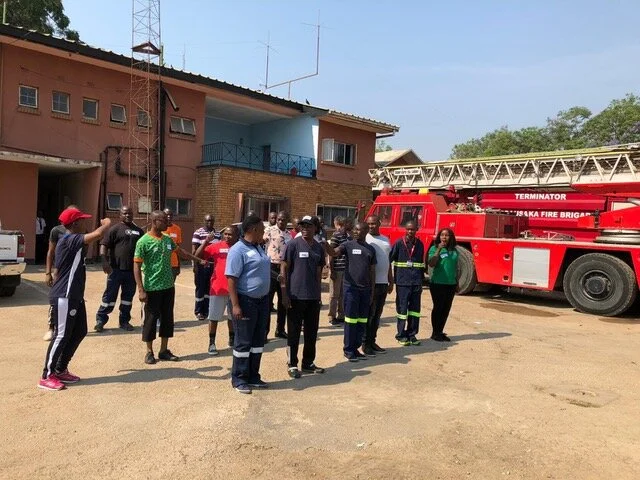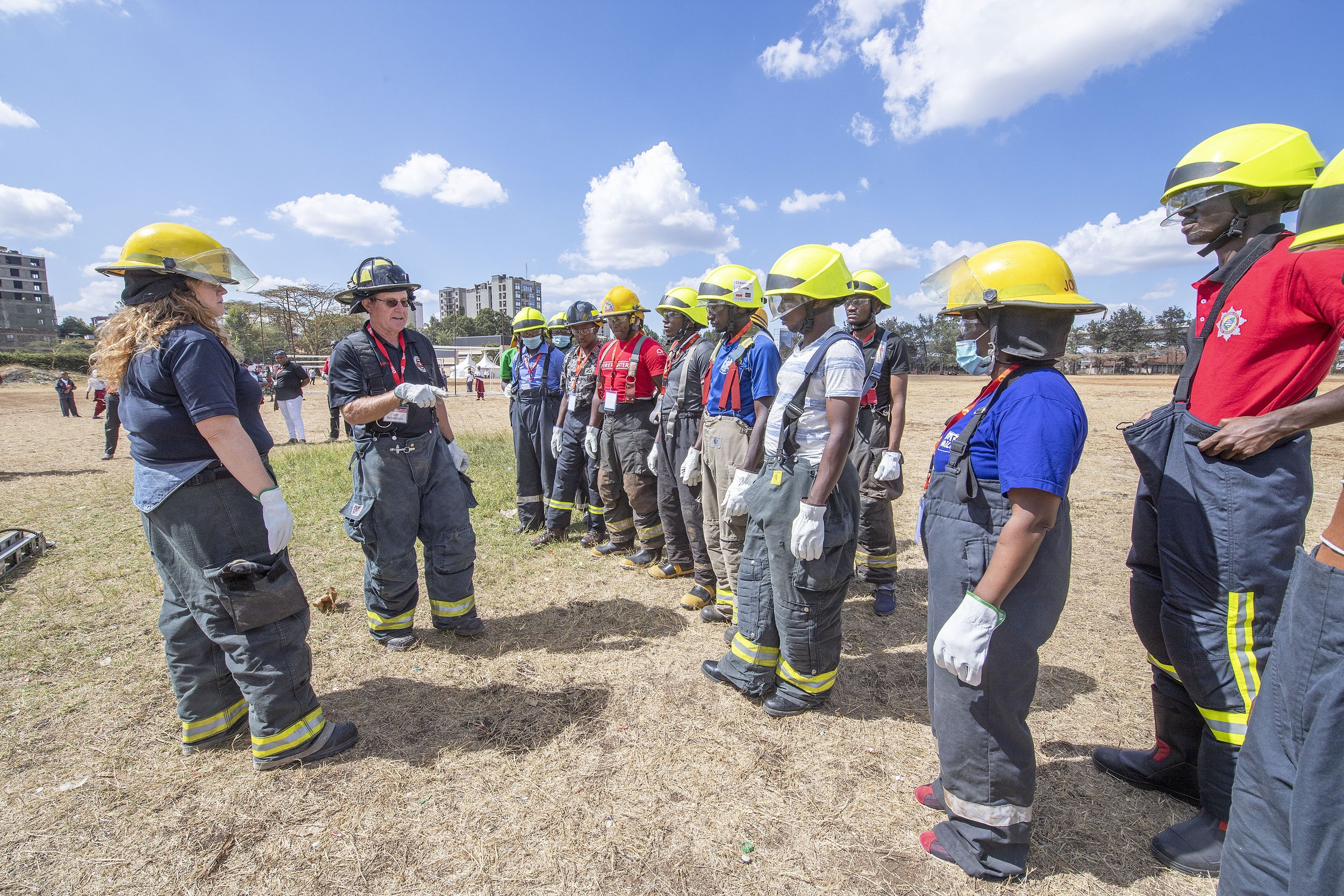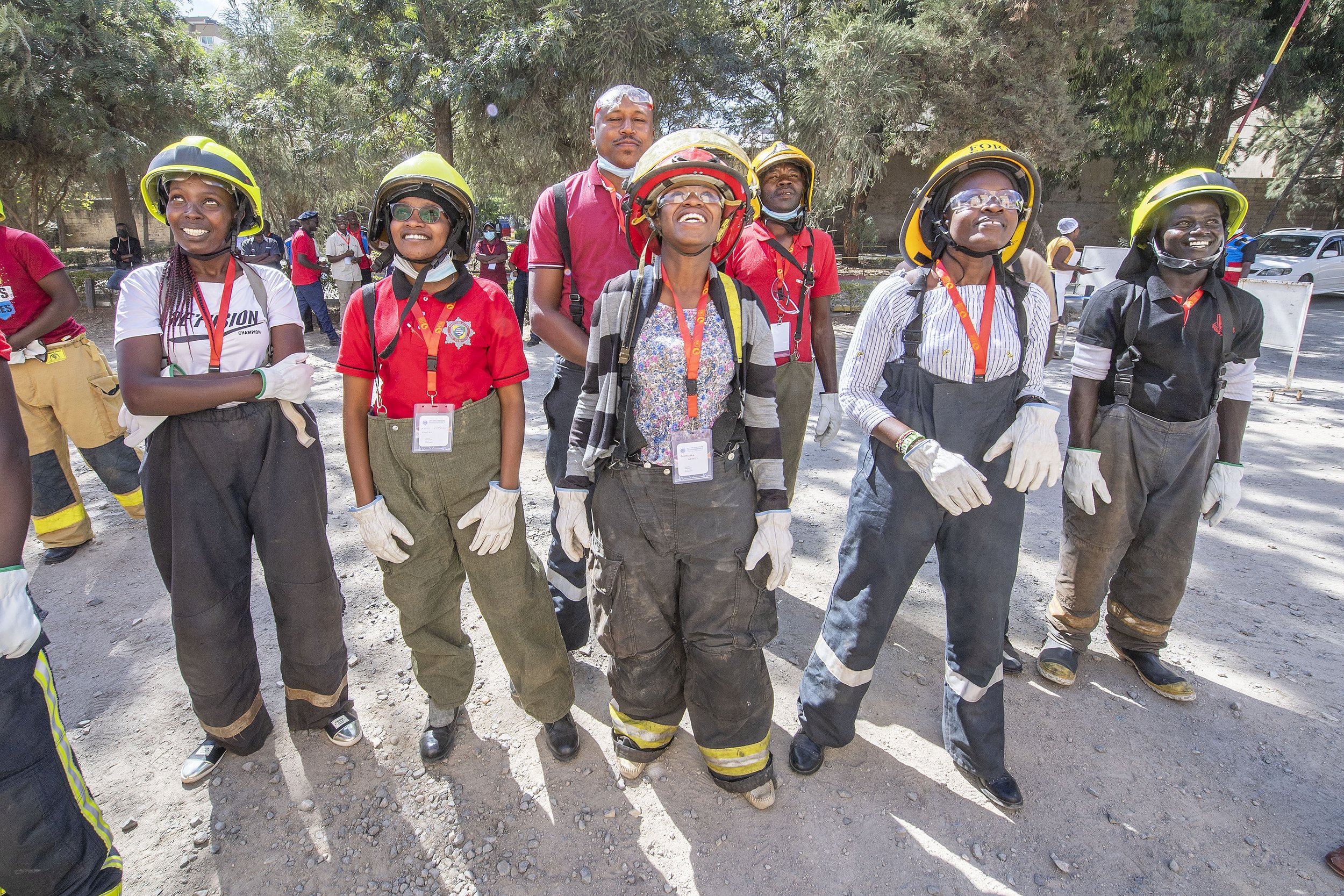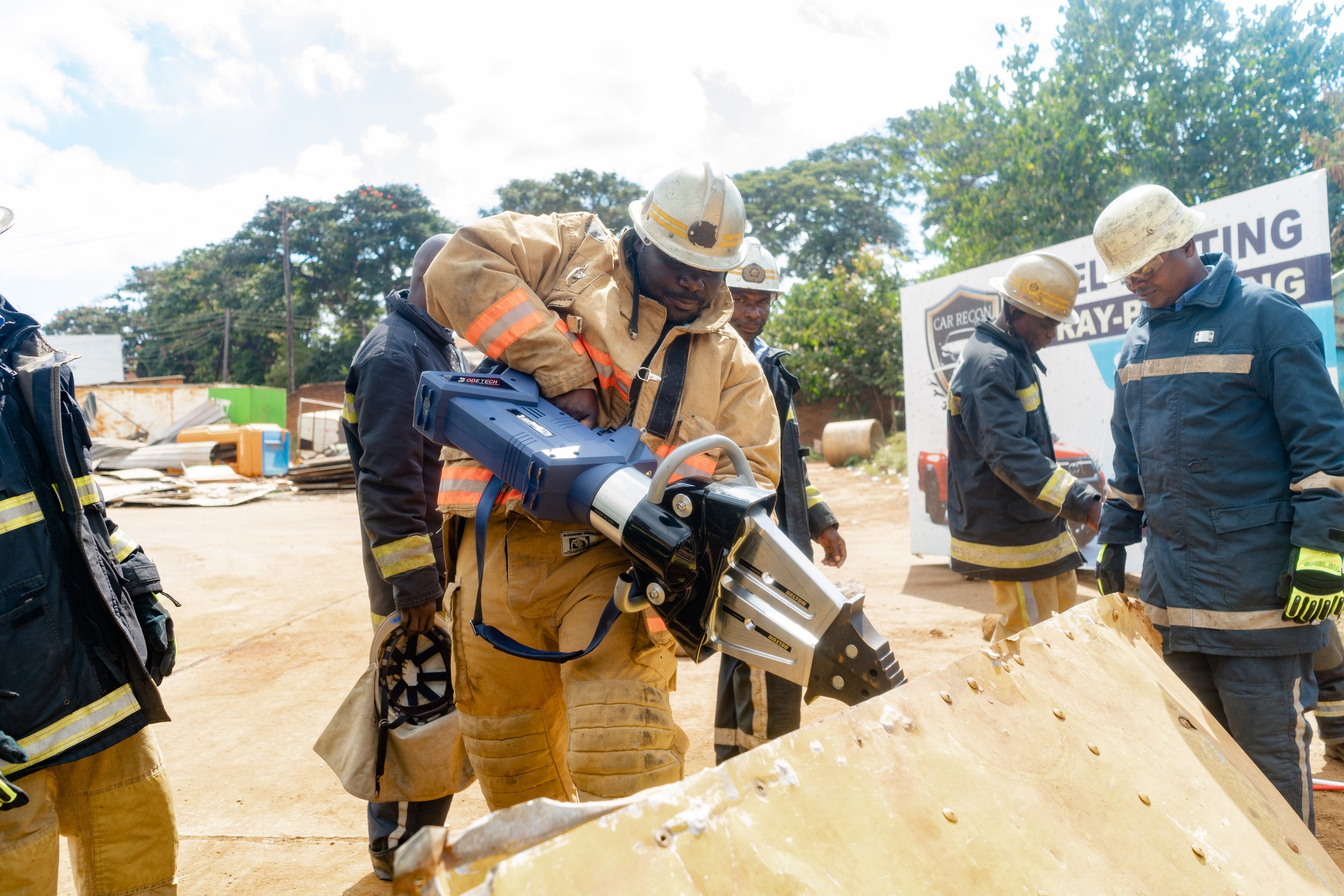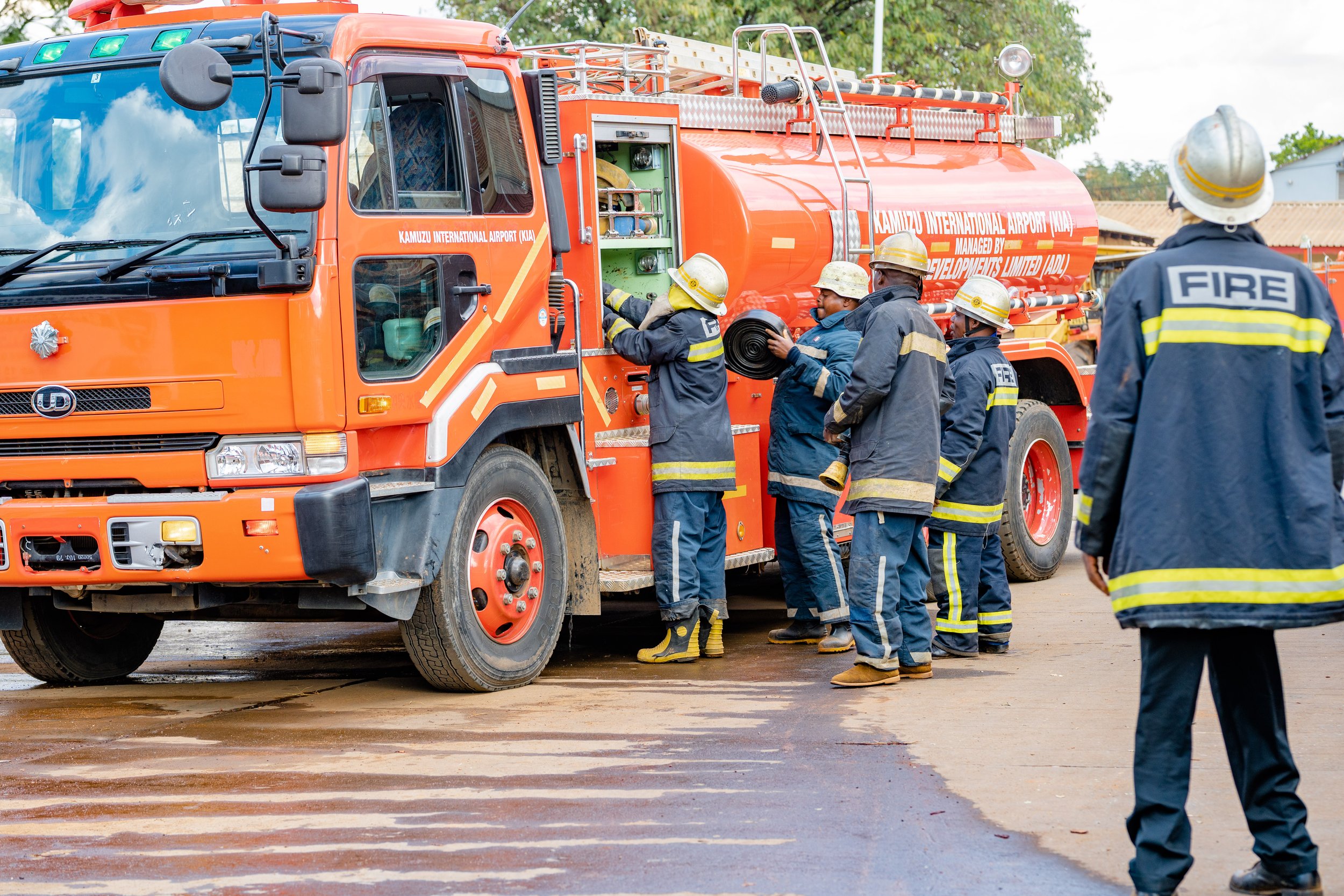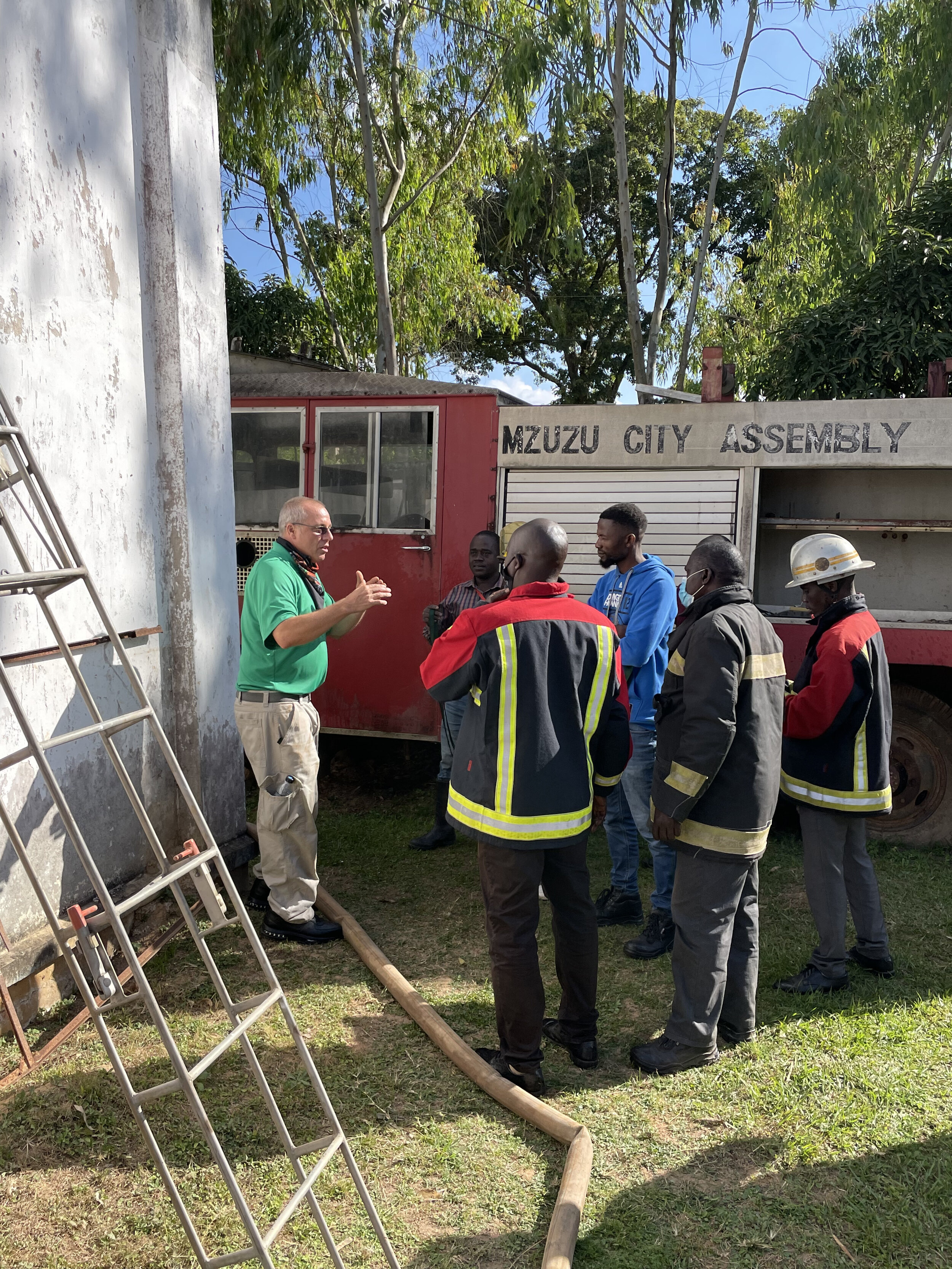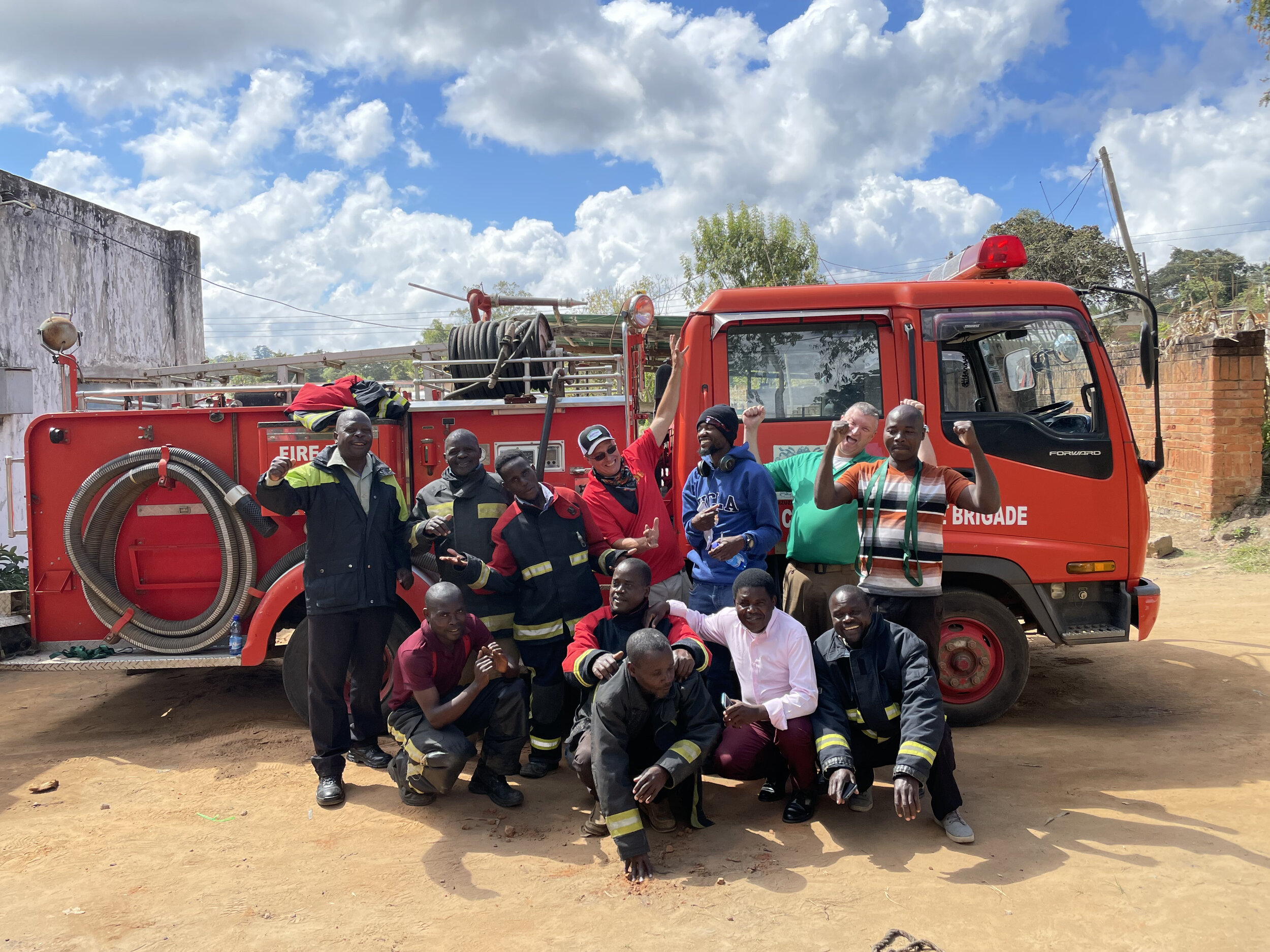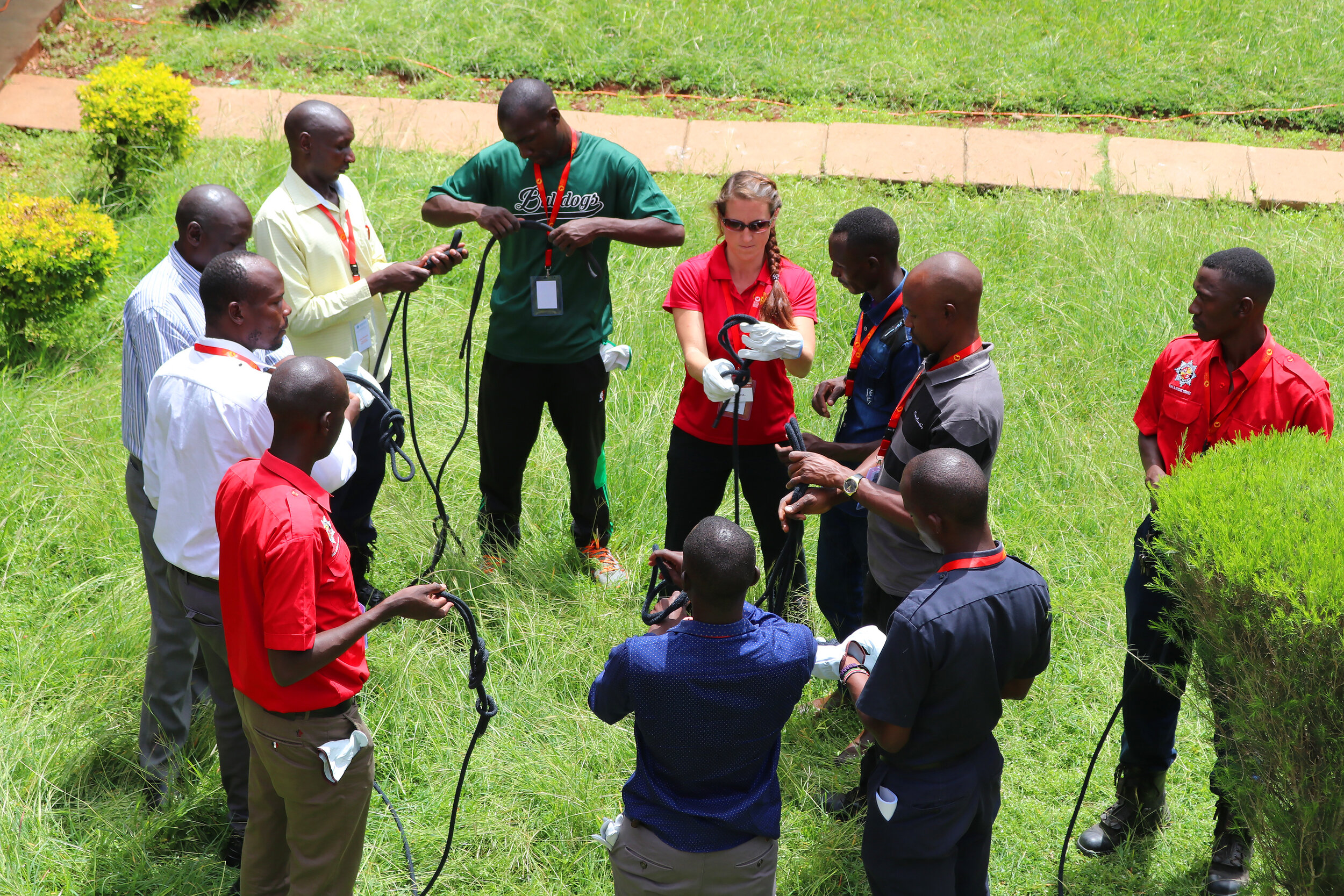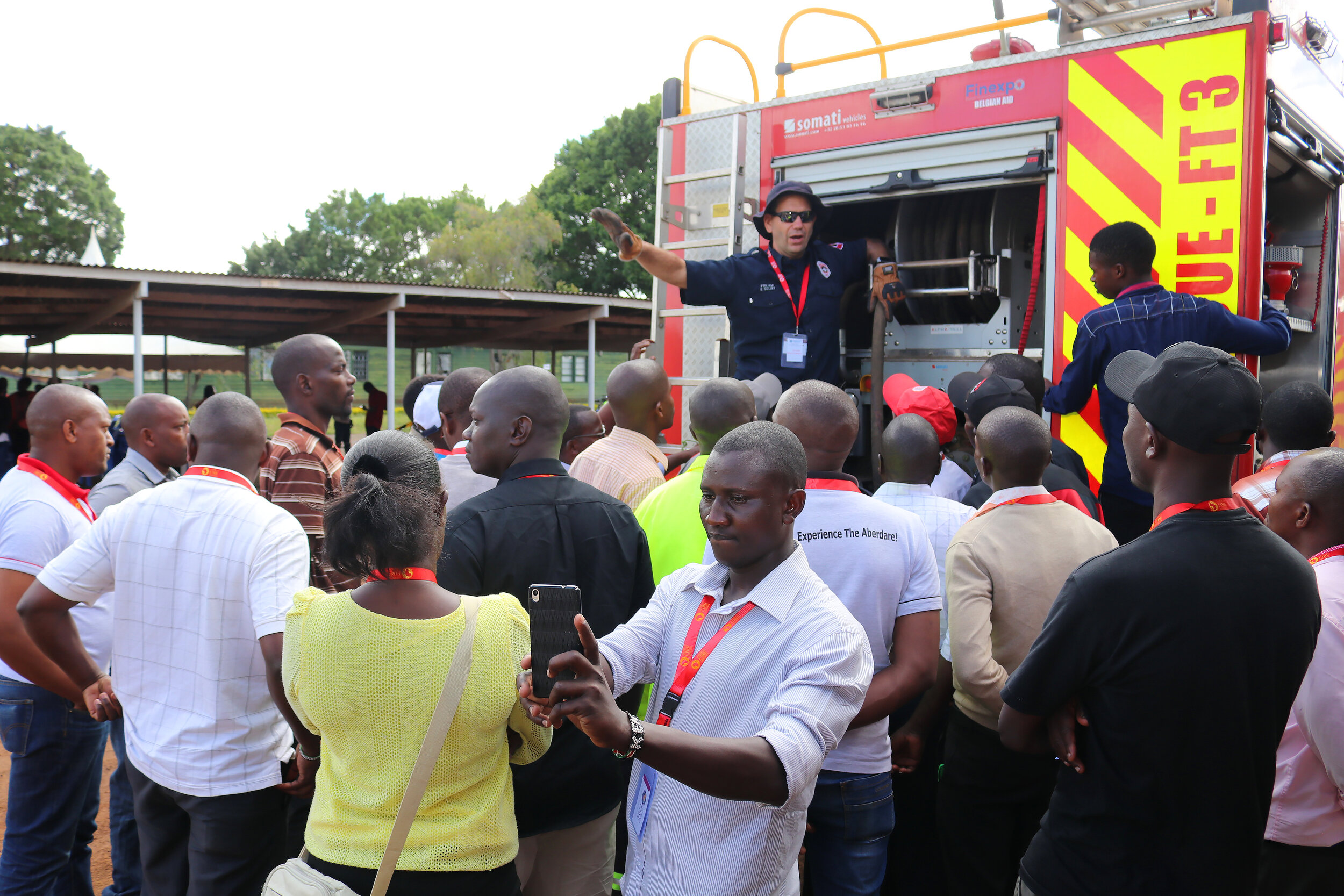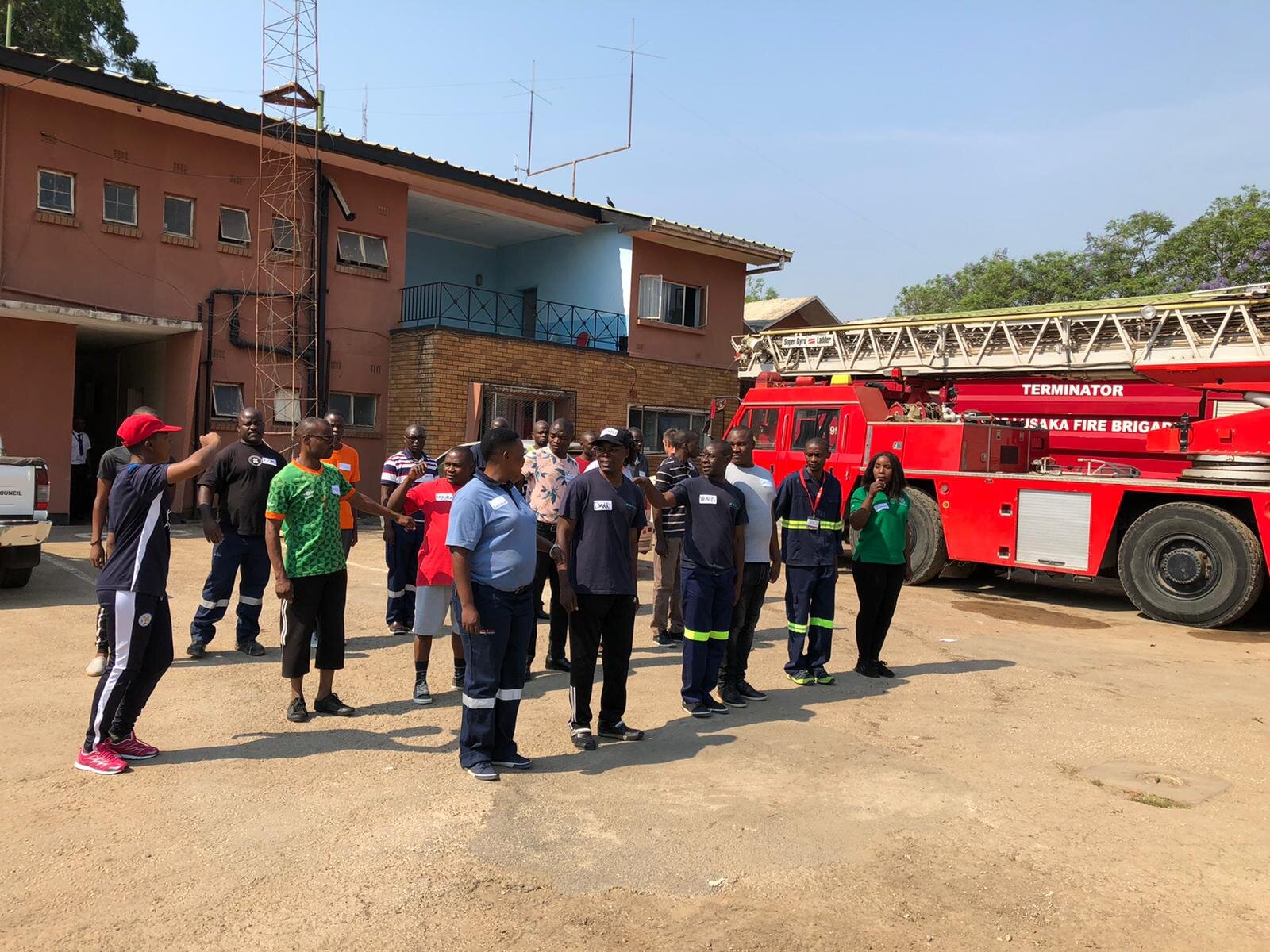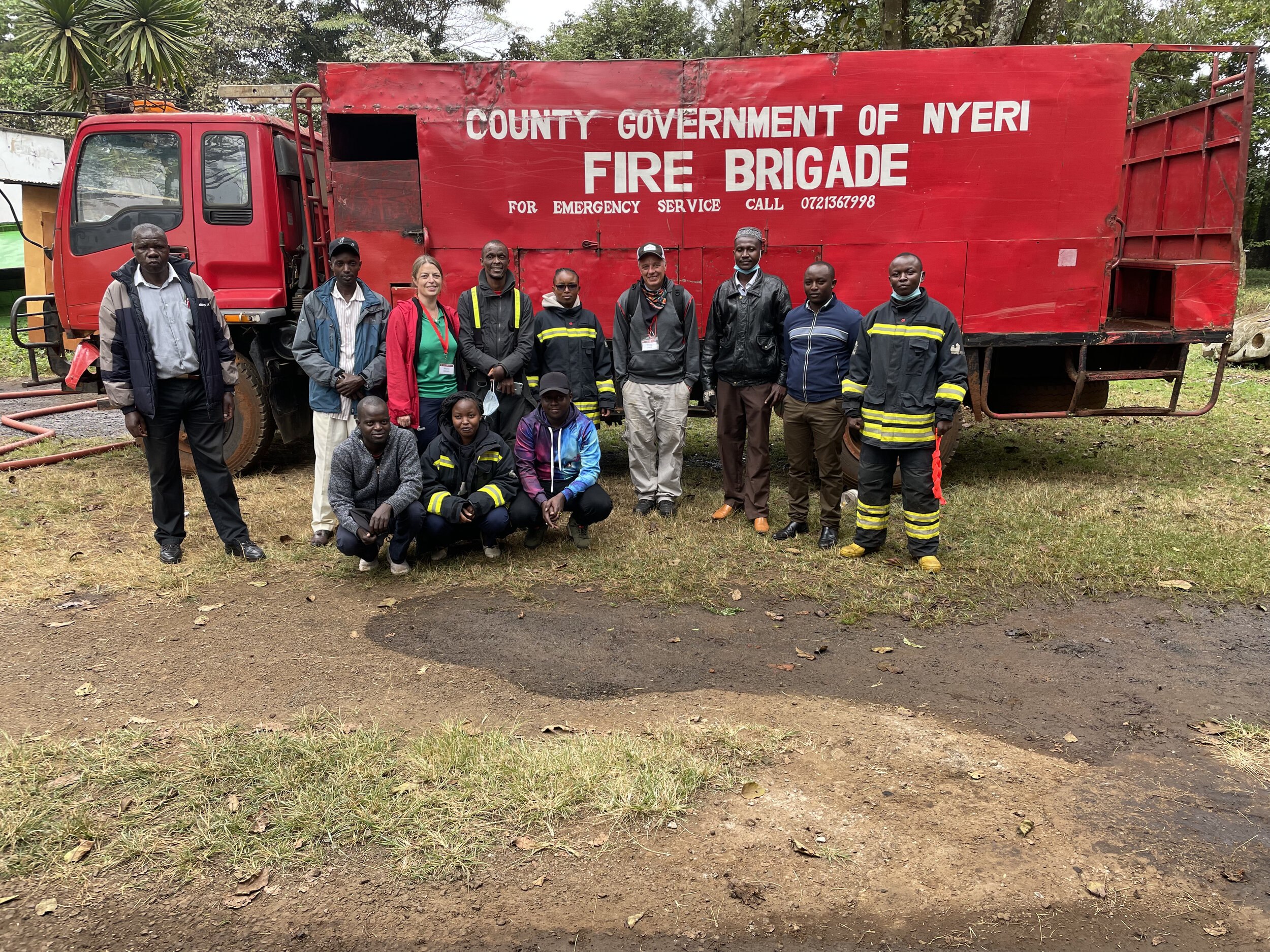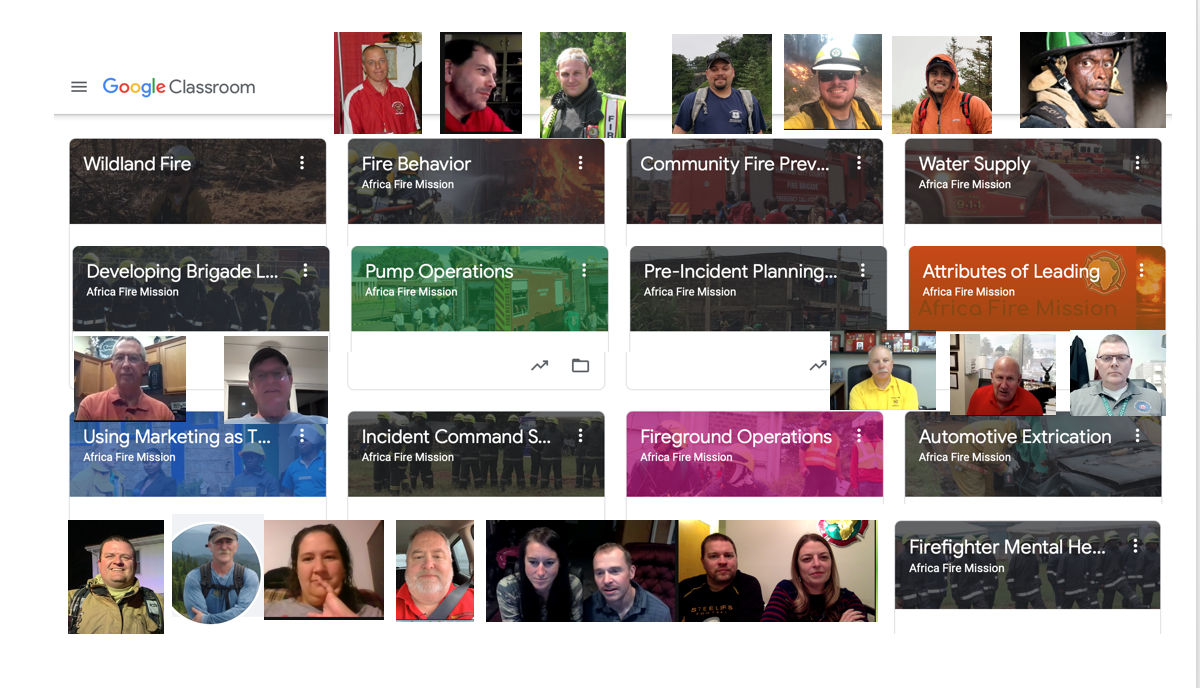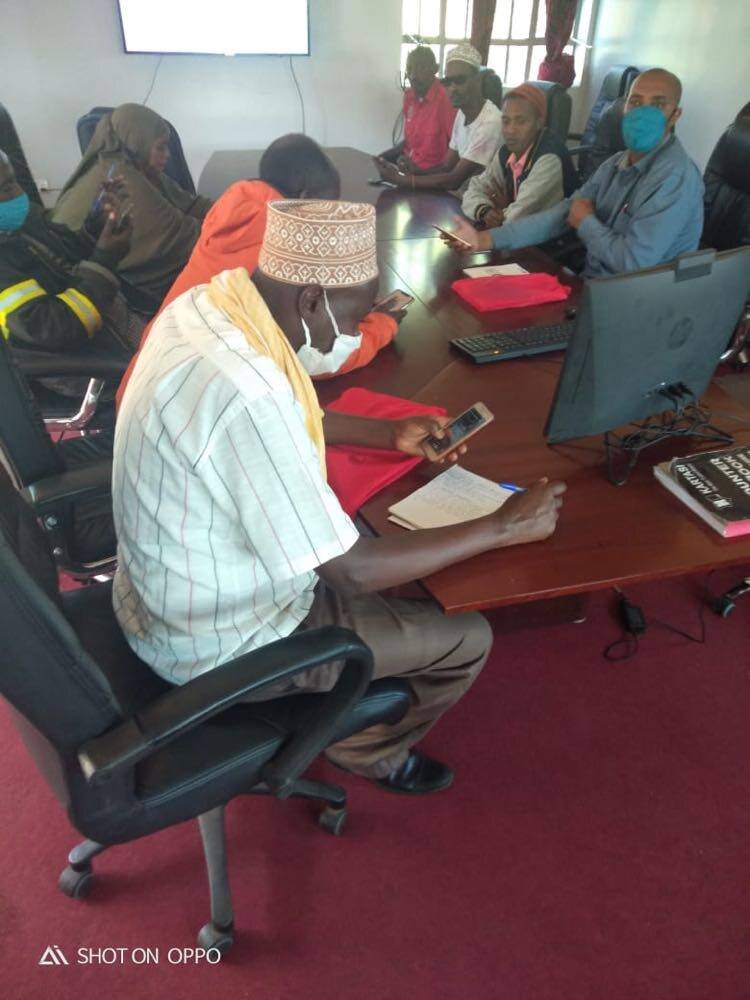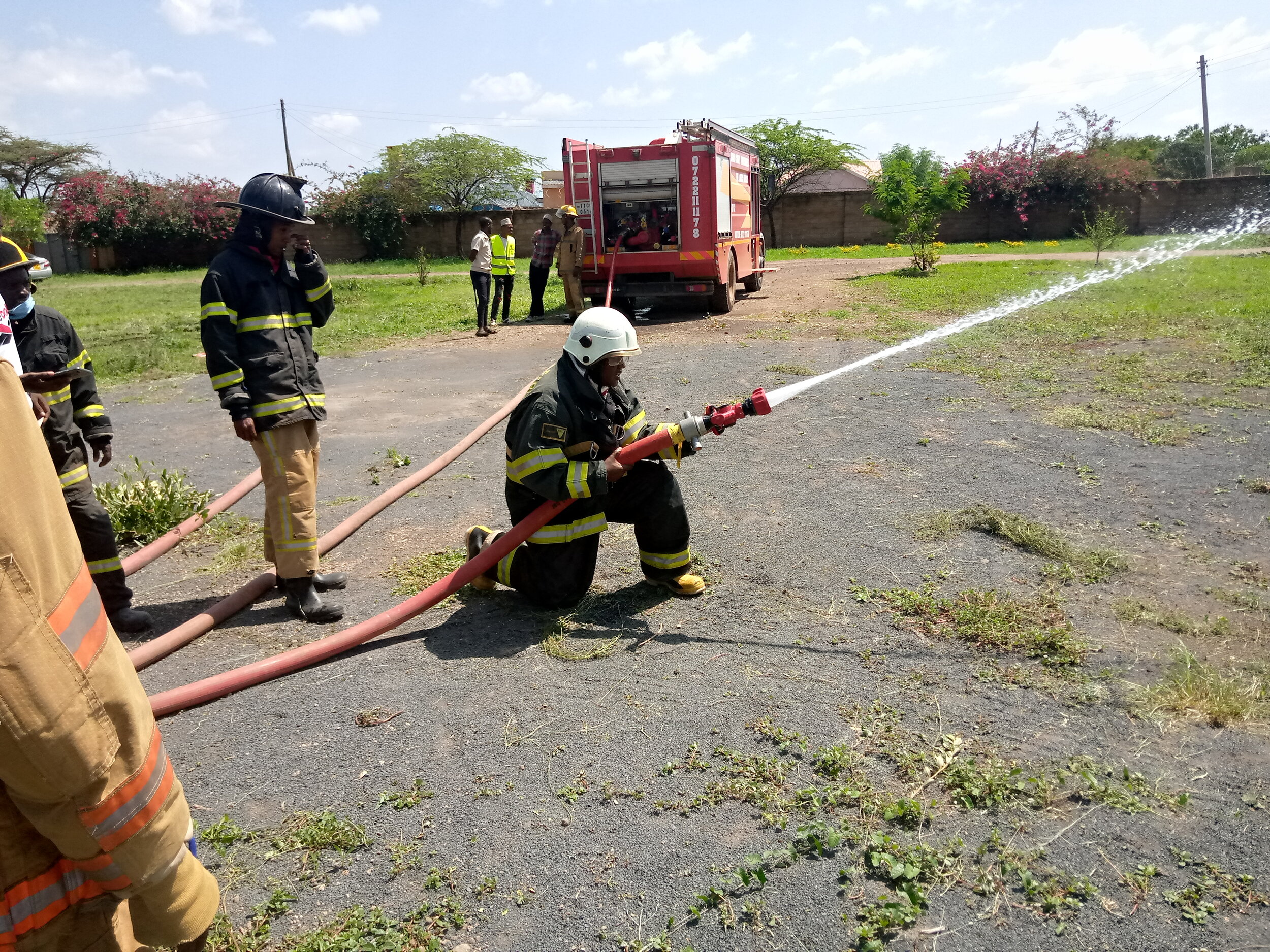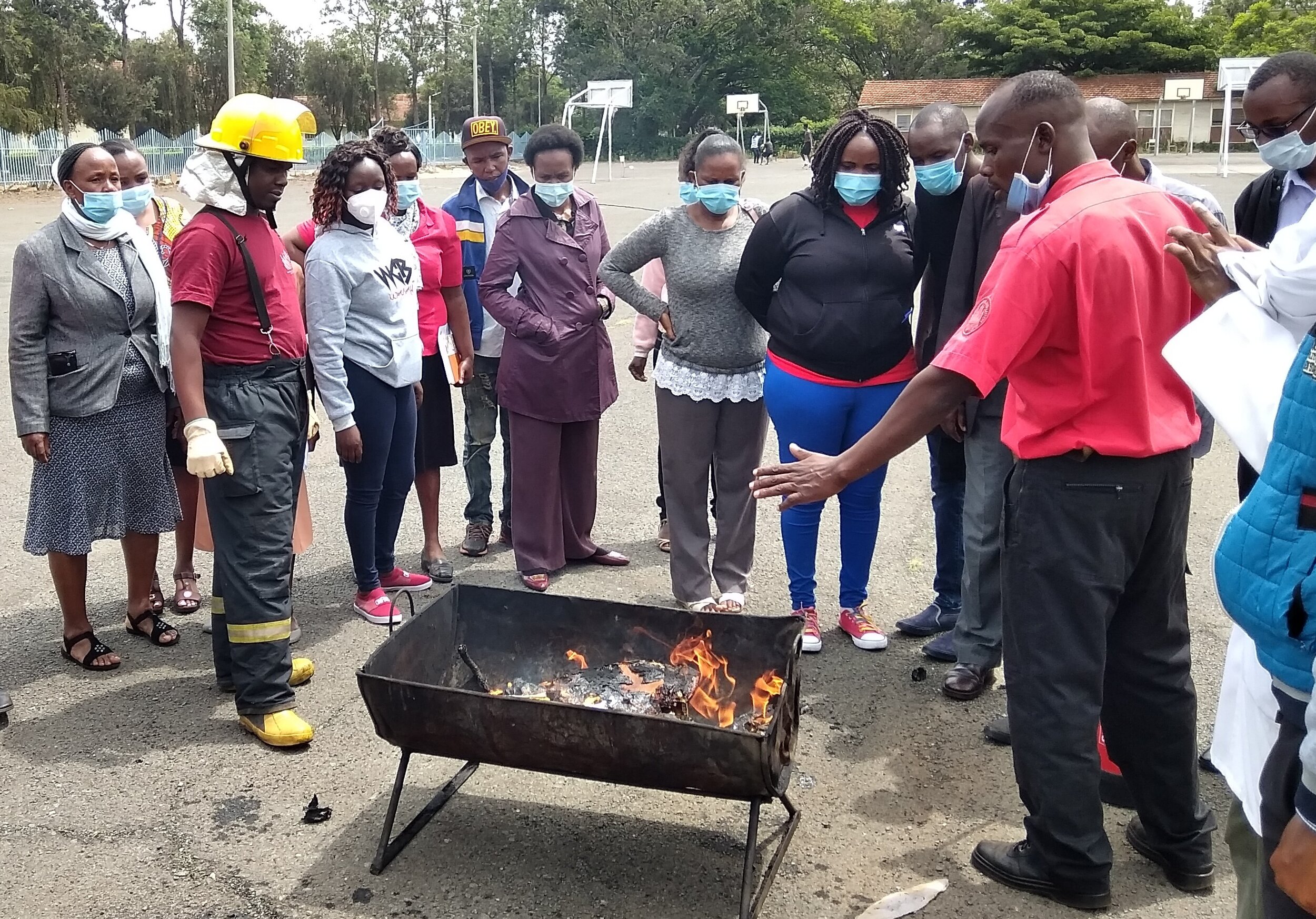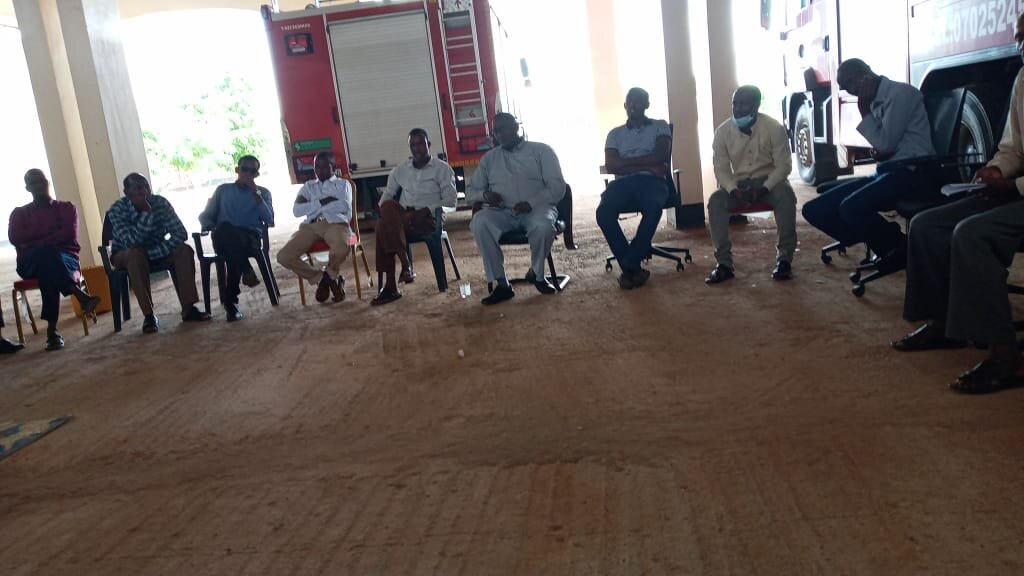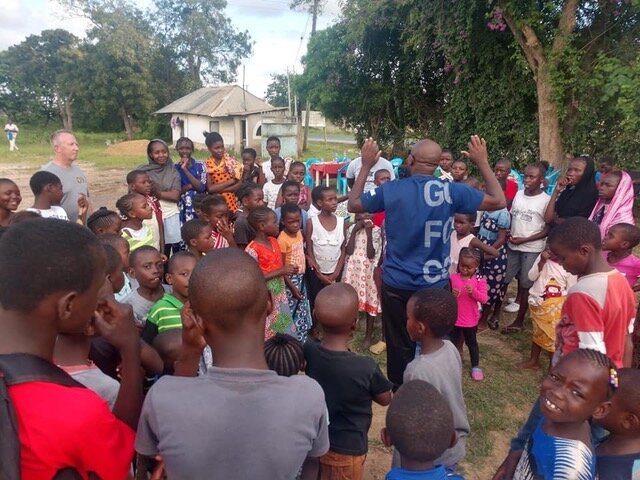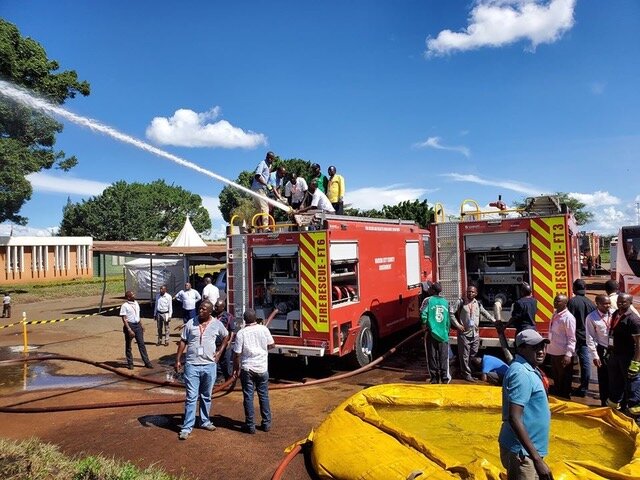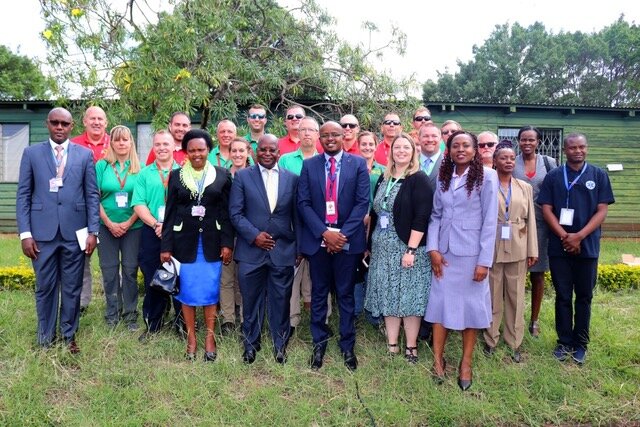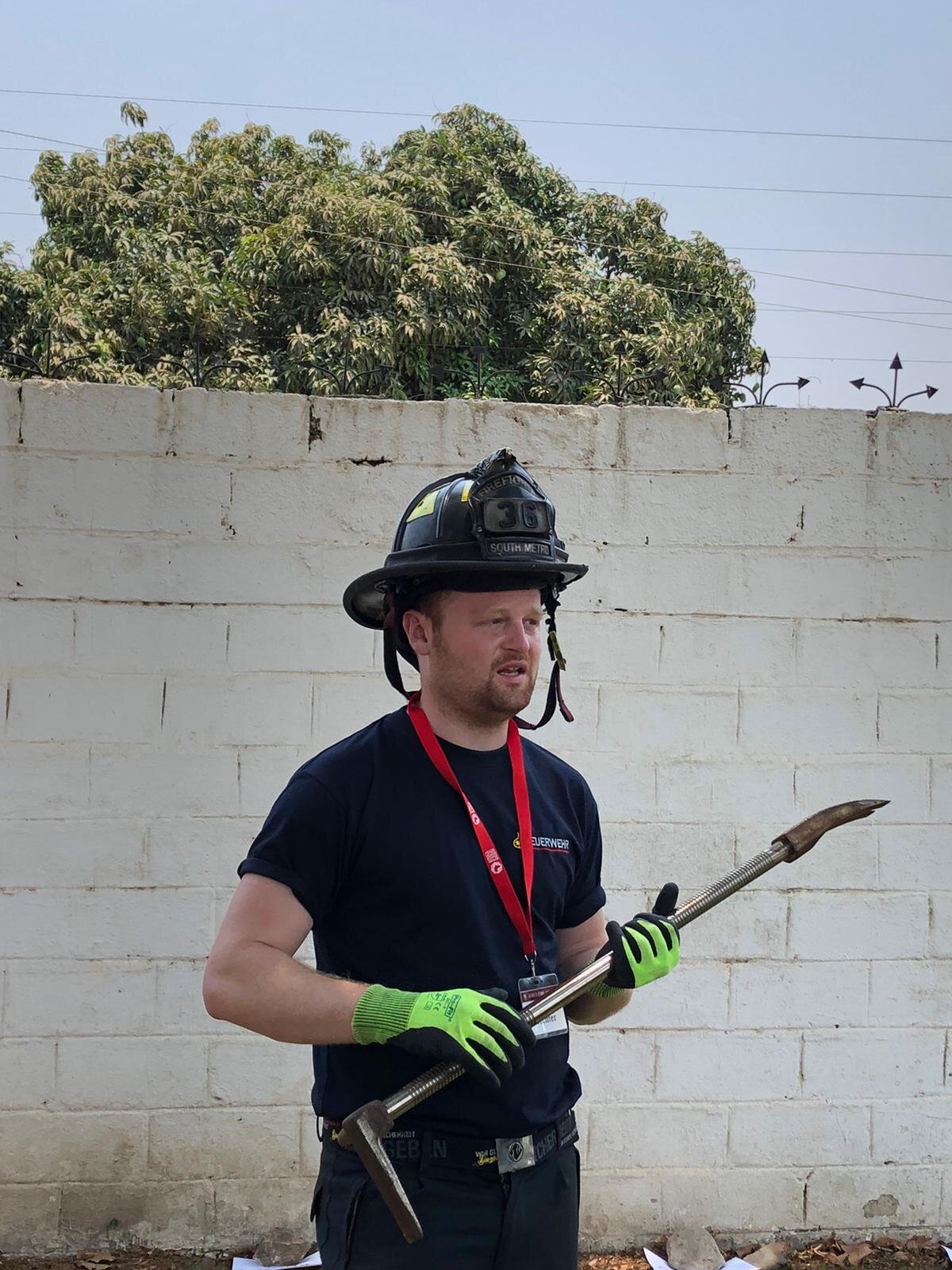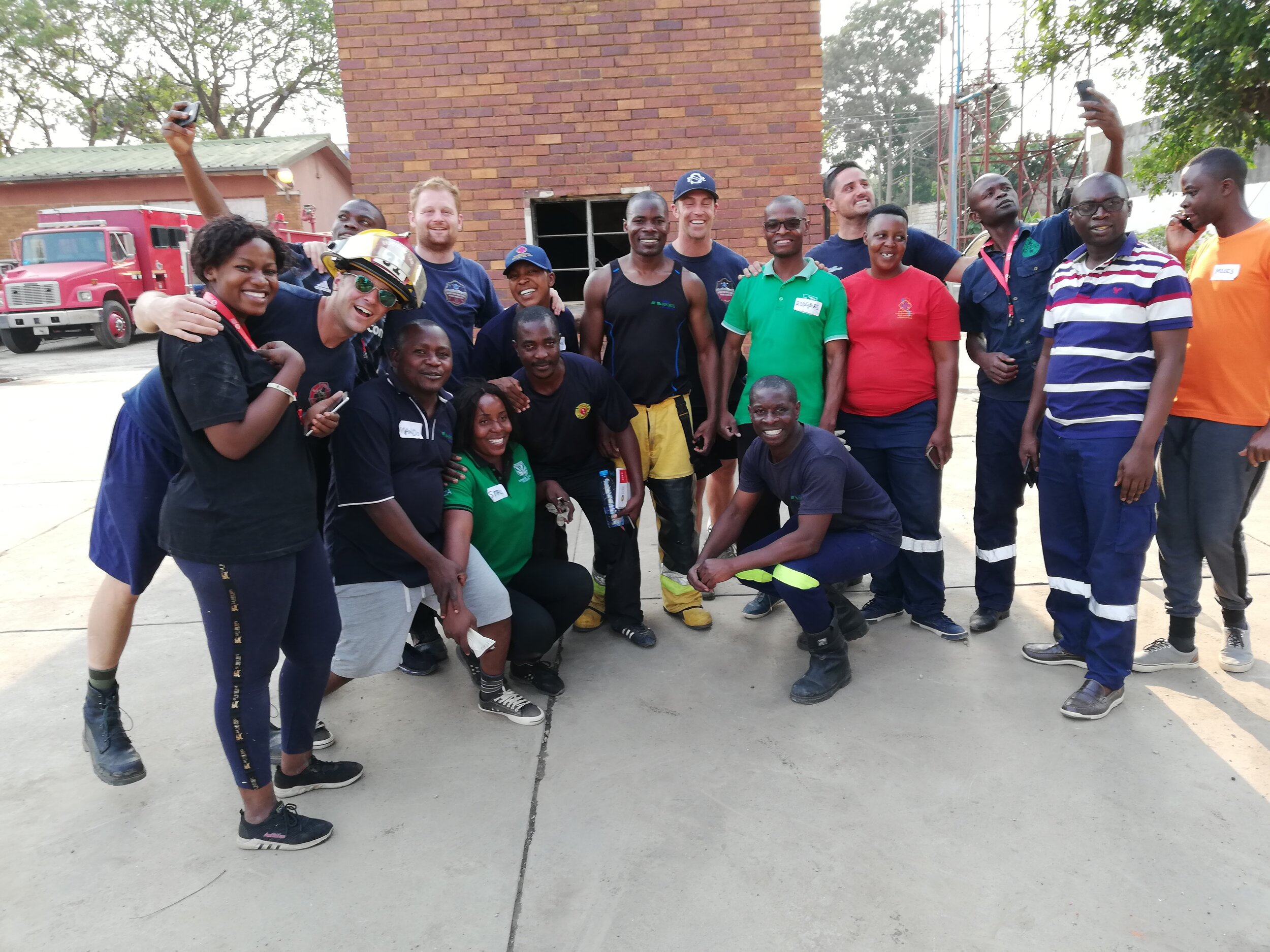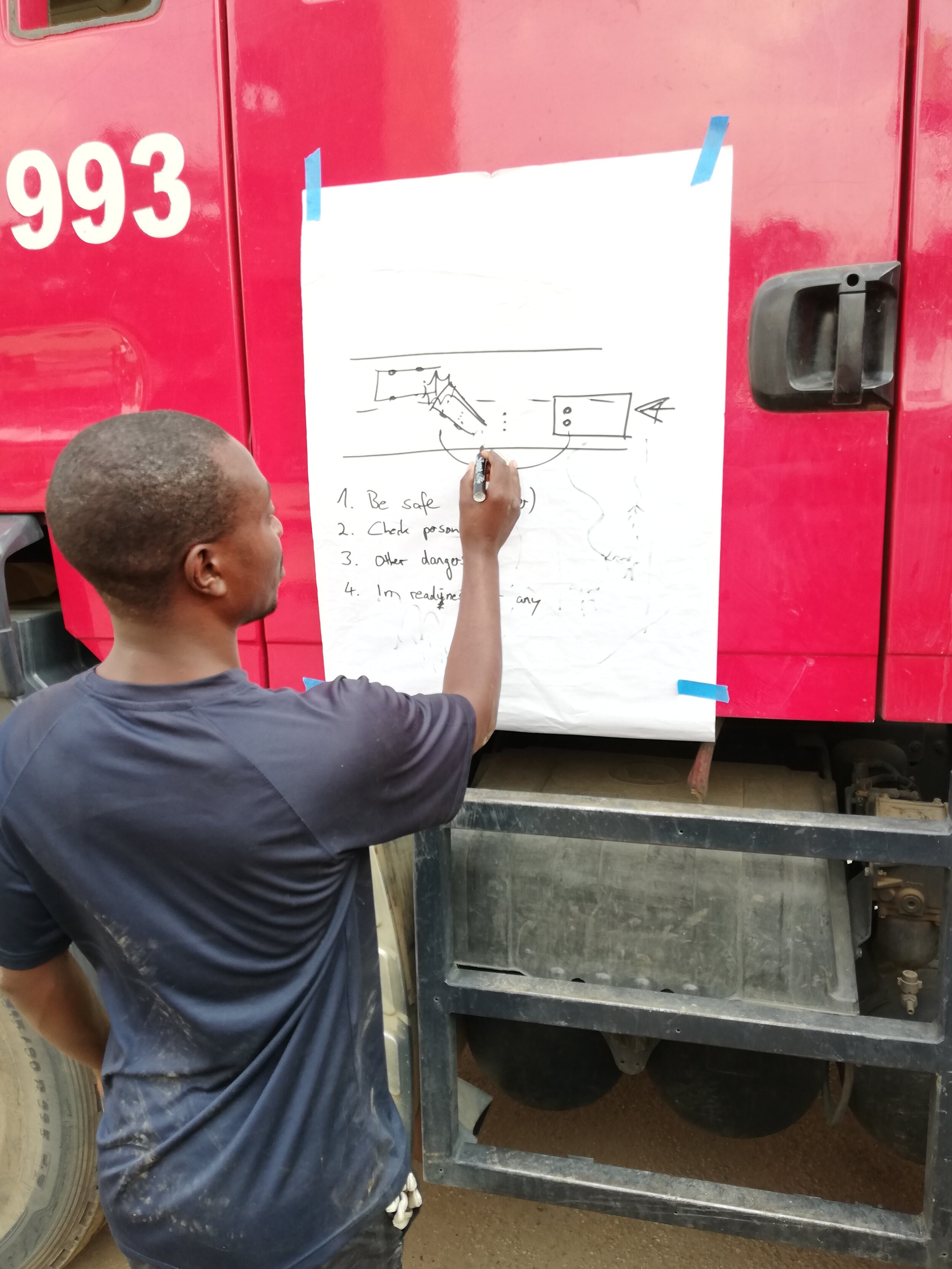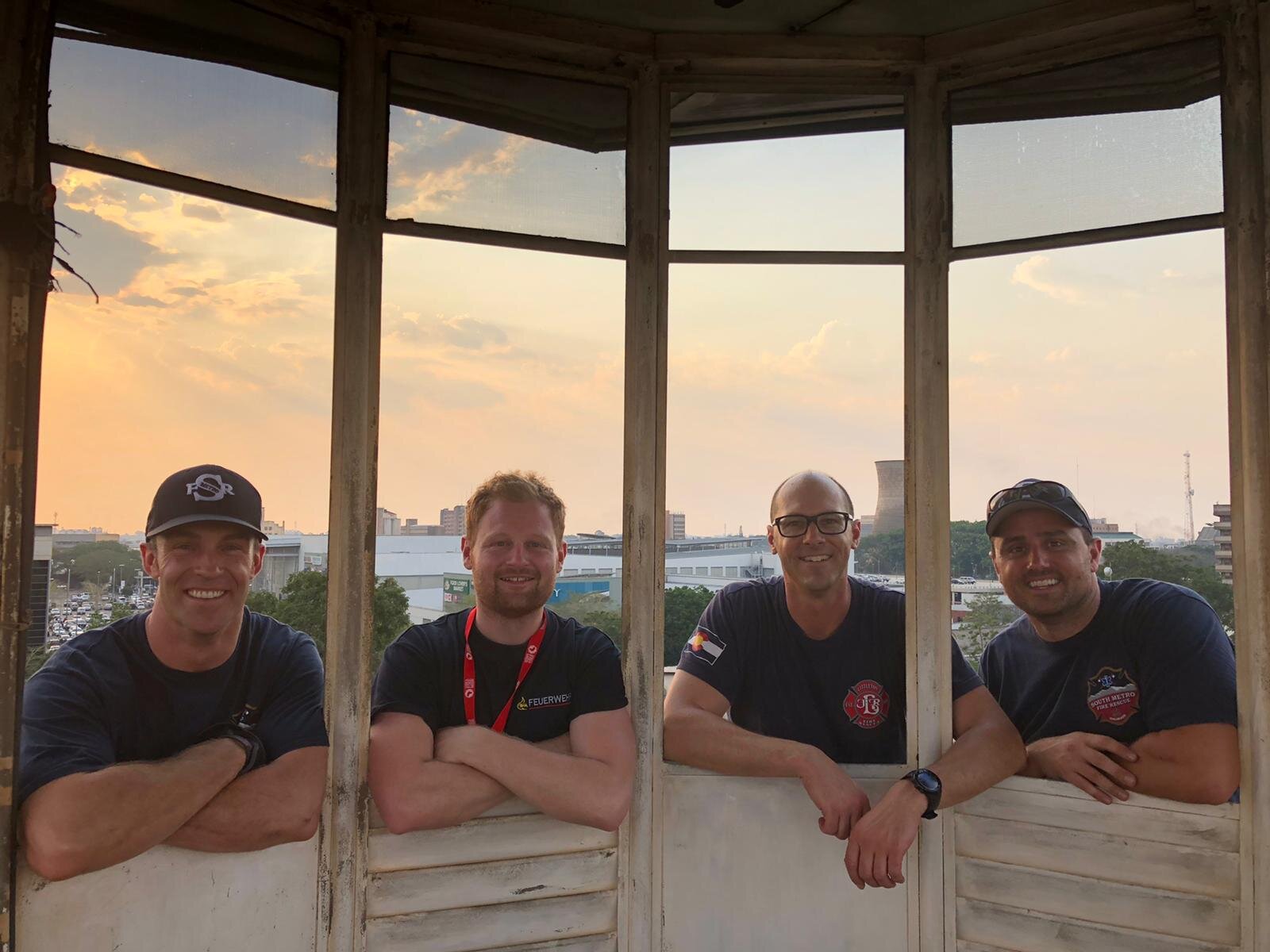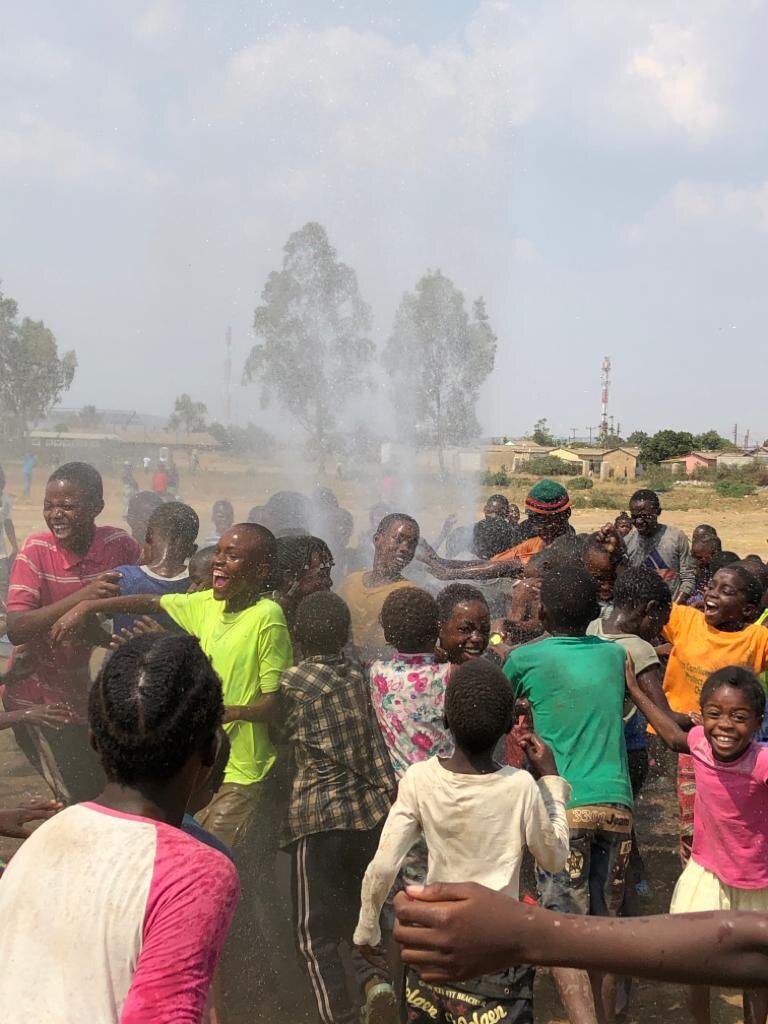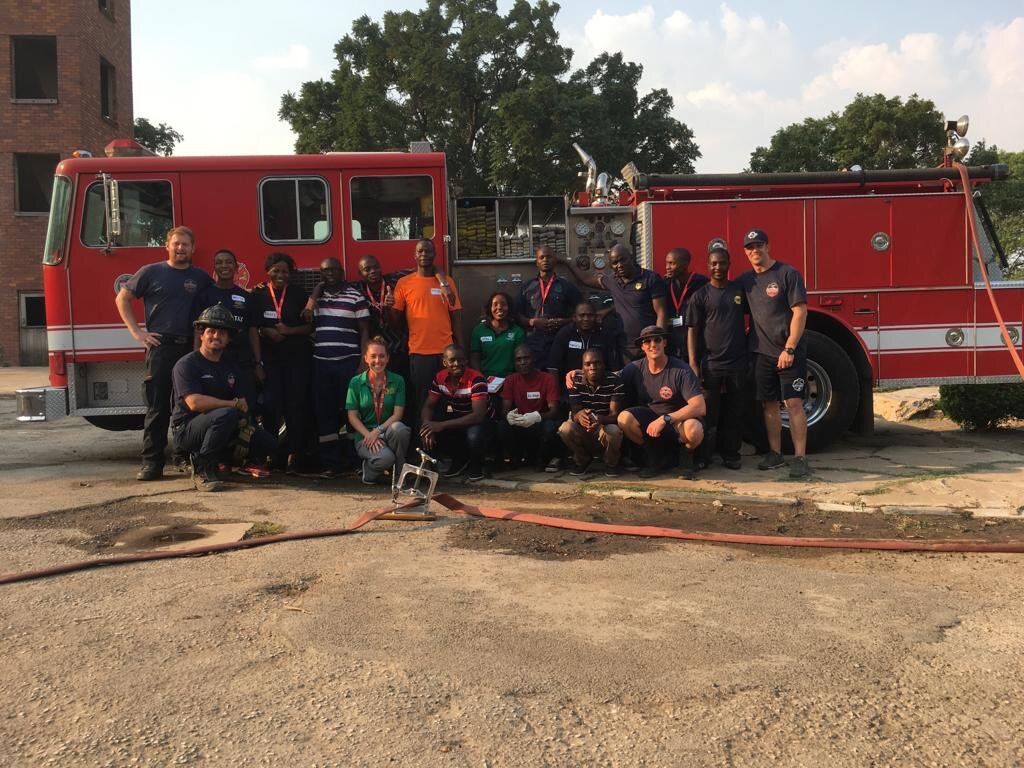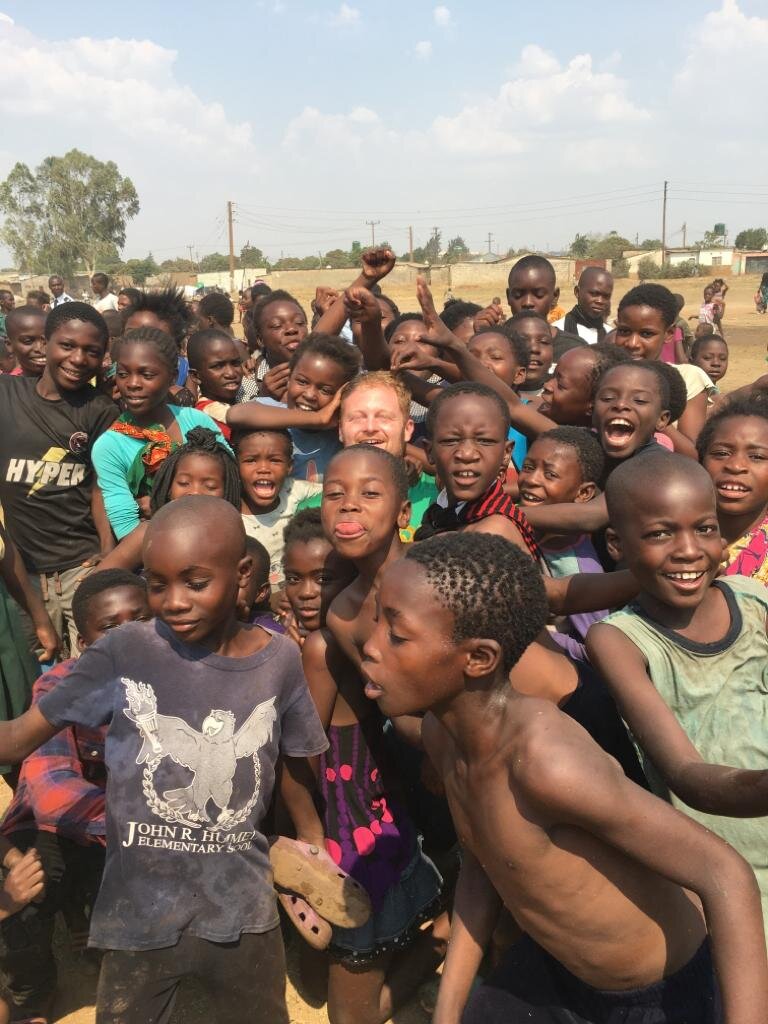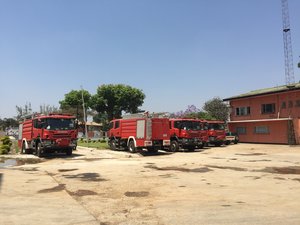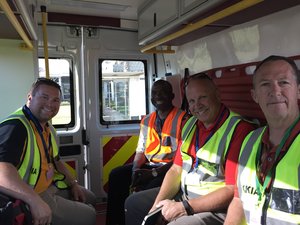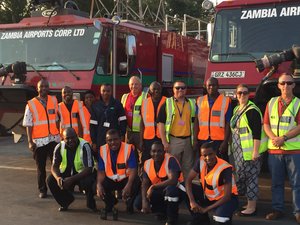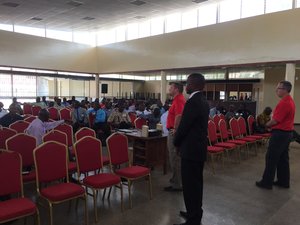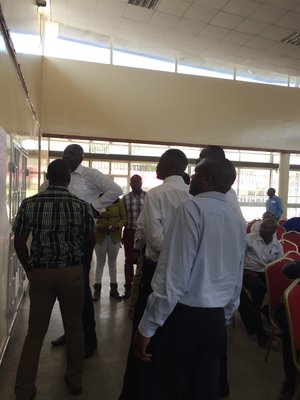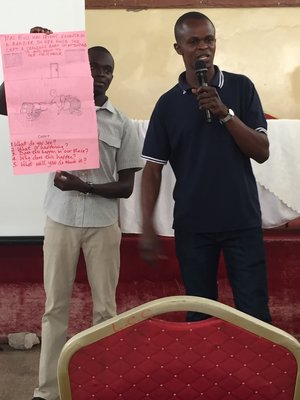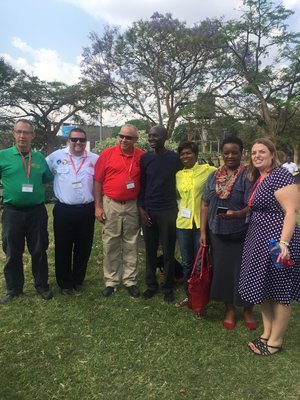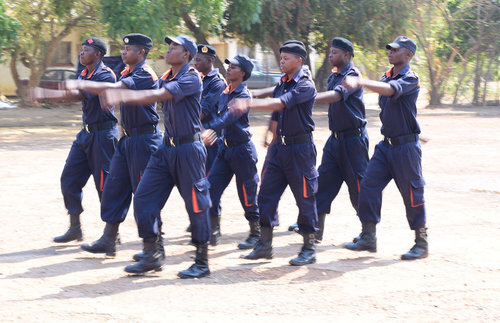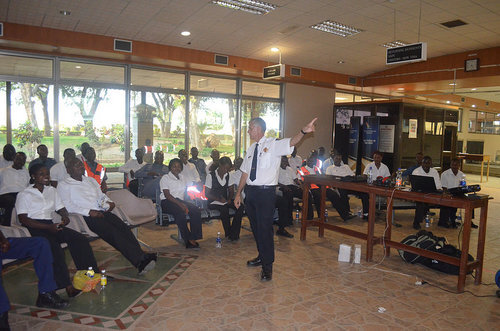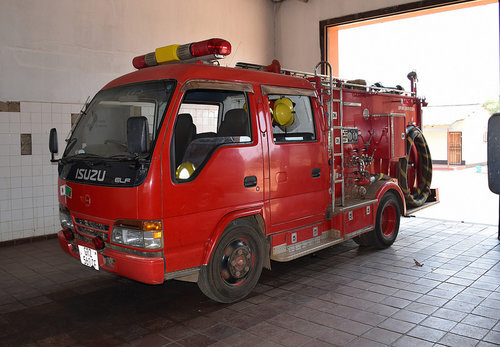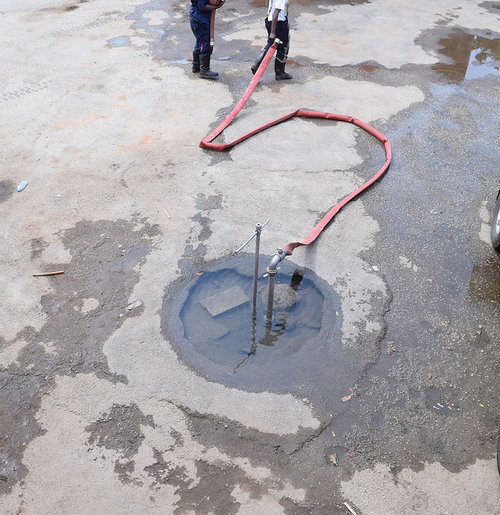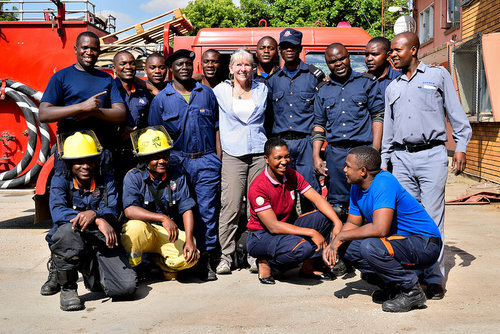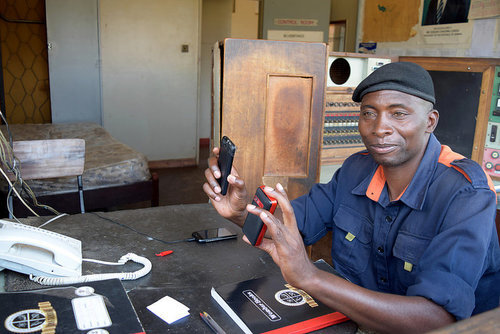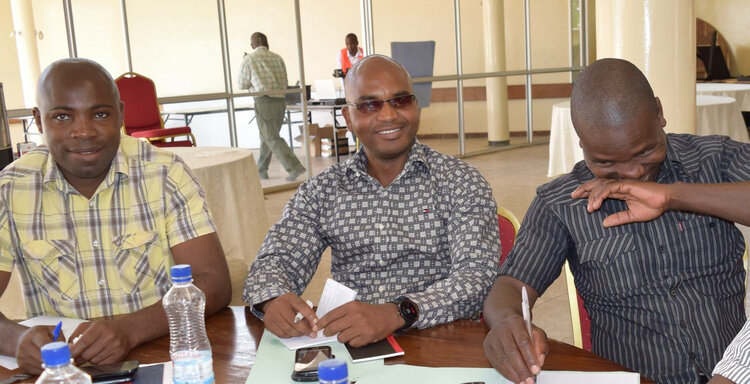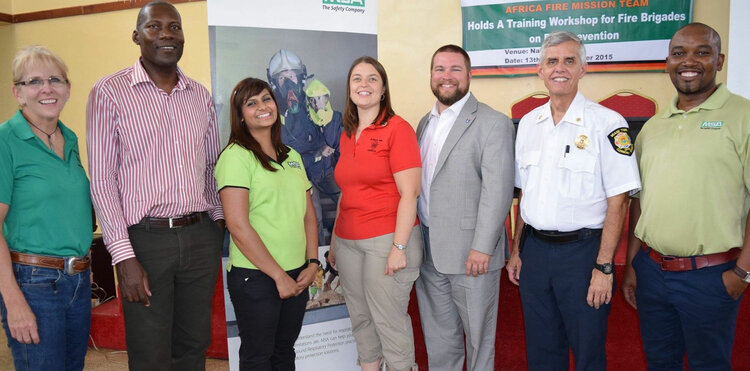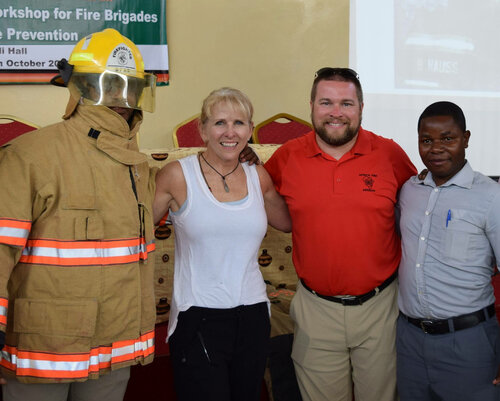In June, AFM visited Zambia to reconnect with stakeholders. AFM’s work in Zambia has been on hold since the Covid-19 pandemic, and we are grateful to return to Zambia to discover new possibilities of engaging with the fire service.
Africa Fire Mission Supports Fire Service Development with White Papers
Africa Fire Mission Supports Fire Service Development with White Papers
by Nancy L. Moore, LISW-S, LCSW, CPCC, Executive Director and Co-Founder of AFM
It’s hard to believe that Africa Fire Mission has been working in Africa for over a decade. Since 2012, we have been working closely to provide training and consultation to the Fire Service in Africa. While our largest program is in Kenya, we have also worked directly in Zambia, Malawi, Ghana, Nigeria and Ethiopia. We have provided consultation or equipment in other countries across Africa as well.
As we support the fire service, we continue to look for ways that we can grow our impact. Our next step in supporting the African fire service in developing communities is by providing more advocacy resources that will help leaders in Africa to be able to support a well functioning fire service. In order to support our advocacy efforts, AFM is drafting white papers to help provide quality information for African leaders to support decision making with developing programs, making equipment purchases or accepting used equipment donations.
All too often AFM has seen situations when fire service leaders know what they need and have a hard time articulating the need or justifying the costs of quality programs and equipment to the government officials making the budgetary decisions. Our hope is to provide quality information that is designed to support these advocacy efforts.
Our first white paper is now available and addresses the need for a quality Breathing Apparatus Program. Let us know what you think. More importantly, please utilize the white paper as a tool for advocacy when you need support!
Africa Fire Mission Receives Major Grant from Motorola Solutions Foundation
For Immediate Release
August 29, 2022
Africa Fire Mission Receives Major Grant from Motorola Solutions Foundation
Africa Fire Mission (AFM) is a Cincinnati-based non-profit organization with team members of firefighters from across the United States, Canada and Europe who for ten years have provided fire training and equipment in various parts of Africa. AFM has announced that they have received a $25,000 grant from the Motorola Solutions Foundation to help continue its training programs and to provide a national Fire and EMS Training Symposium and Competition in Kenya in November 2022.
This grant will support hands-on Fire Training and distribution of firefighter personal protective equipment (PPE). In November, a team of twenty-two firefighters, paramedics and nurses from the United States and Canada will train over 350 Kenyan firefighters and EMT’s at the Jomo-Kenyatta International Airport in Nairobi, Kenya.
AFM’s training team members volunteer their time and pay their own expenses to travel to Africa to teach their fellow firefighters the latest techniques in firefighting, rescue and emergency medical services.
“Africa Fire Mission is grateful to Motorola Solutions Foundations for its continued support of our programs through this grant. Through continued partnership, we will be able to continue to impact communities and support firefighters in Africa as they strive to save lives and property” says Nancy Moore, Executive Director for Africa Fire Mission.
The Motorola Solutions Foundation, which has donated $100 million over the past 10 years, focuses its giving on three key areas: first responder programming, technology and engineering education, and programs that blend the two. The Foundation has a long-standing commitment to supporting programs that benefit underrepresented populations and aims to partner with organizations that align to its values of accountability, innovation, impact, diversity and inclusion.
The Motorola Solutions Foundation is proud to partner with organizations like Africa Fire Mission that share our values and passion for driving positive change in the community,” said Karem Perez, Executive Director of the Motorola Solutions Foundation. “We believe in the work that Africa Fire Mission is doing and look forward to seeing their continued impact.
For additional information on the Motorola Solutions Foundation grants program, visit: motorolasolutions.com/foundation-grant-partner.
For additional information regarding Africa Fire Mission visit: www.africafiremission.org - Contact Nancy Moore at 513-620-4236 or nancy@africafiremission.org
About Africa Fire Mission
Africa Fire Mission is a nonprofit organization committed to increasing the sustainable capacity of Fire Departments in developing communities. We accomplish this through training, empowerment, support and encouragement.
· Train – We partner with governments, NGO’s, missionaries, schools and corporations to provide education and training to firefighters and local communities. We use Community Health Education to teach firefighters and community members in Africa to protect themselves from the dangers of fire. We provide fire prevention training and fire safety assessments to schools ensuring the students are able to learn in an environment safe from fires.
· Empower – We work to increase the ability of communities in Africa to respond to disasters and provide relief when disasters occur.
· Support – We provide personal protective equipment and communication tools to fire services throughout Africa to allow fire departments to operate in a safer and more coordinator manner.
· Encourage – We build the capacity of African fire services so that local communities are able to provide sustainable public safety and disaster management services.
Where does AFM work?
Africa Fire Mission currently works in 6 countries throughout Africa including: Ethiopia, Ghana, Kenya, Malawi, Sierra Leone, and Zambia. In 2022, we are expanding our consultation work into Nigeria. In 2018, a request to expand our services into Ukraine has led us outside of Africa and into Europe.
About the Motorola Solutions Foundation
As the charitable and philanthropic arm of Motorola Solutions, the Motorola Solutions Foundation partners with organizations around the globe to create safer cities and equitable, thriving communities. We focus on giving back through strategic grants, employee volunteerism and other community investment initiatives. Our strategic grants program supports organizations that offer first responder programming and technology and engineering education, and align to our values of accountability, innovation, impact, diversity and inclusion. The Foundation is one of the many ways in which the company lives out its purpose of helping people be their best in the moments that matter. For more information on the Foundation, visit: www.motorolasolutions.com/foundation
Africa Fire Mission Receives Major Grant from Motorola Solutions Foundation
For Immediate Release
September 28, 2021
Africa Fire Mission Receives Major Grant from Motorola Solutions Foundation
Africa Fire Mission (AFM) is a Cincinnati-based group of firefighters from across the United States who for nearly a decade have provided fire training and equipment to several African nations. AFM has announced that they will receive a $ 30,000 grant from the Motorola Solutions Foundation to help continue its outreach to train several fire brigades in Kenya, Malawi, and Zambia through 2022.
This grant will support hands-on Fire Training and distribution of personal protective equipment (PPE) turnout gear scheduled for delivery in Kenya, Malawi and Zambia. The 2021 Kenya trip that will take place from November 10th to 21st, will be partially supported by this grant, as well as four other scheduled team trips in 2022.
This distribution of needed fire equipment and training is only possible through the generosity of such organizations as the Motorola Solutions Foundation funded through the Motorola Corporation, a world-wide leader in the field of emergency communications equipment. The AFM training staff consists of firefighters from departments that span across America, who volunteer their time and pay their own expenses to travel to Africa to teach their fellow firefighters the latest techniques in firefighting, rescue and emergency medical services.
“Africa Fire Mission is grateful to Motorola Solutions Foundations for its continued support of our programs through this grant. We will be able to continue to impact communities and support firefighters in Africa as they strive to save lives and property” says Nancy Moore, Director of Programs for Africa Fire Mission.
AFM is a 501c3 corporation headquartered at 1373West Galbraith Road in North College Hill, Ohio.
Each year, the Motorola Solutions Foundation’s awards grants to charitable organizations such as Africa Fire Mission to support three primary areas of focus: first responder programming, technology and engineering education and programs that blend the two.
"The Motorola Solutions Foundation aims to partner with organizations that align to our values of accountability, innovation, impact, diversity and inclusion," said Karem Perez, executive director of the Motorola Solutions Foundation. "We are proud to support organizations like Africa Fire Mission that embody these values while driving positive change in their communities.”
For additional information:
Motorola Solutions Foundation grants program: www.motorolasolutions.com/foundation - Contact Sarah Packard at sarah.packard@motorolasolutions.com
Africa Fire Mission: www.africafiremission.org - Contact Nancy Moore at 513-620-4236 or nancy@africafiremission.org, or Robert Rielage at 513-728-9978.
Reflections on AFM’s first Virtual Fire Training Symposium
by: Hank Clemmensen, Board Member AFM; Retired Fire Chief, Palatine Rural Fire Protection District, IL
What a year 2020 has been in the United States, from COVID-19 to the protests and riots to some of the worst Western wildfires and hurricanes in the golf shores. At times, we forget that it hasn’t been any better in other parts of the world and some of those places are not as prepared to handle these types of disasters.
This is one of driving forces behind what we do at the Africa Fire Mission, why since 2012 we have traveled halfway around the world to help support the fire service in Africa. I’ve been participating in team trips with AFM since 2015. During the fall of 2019, I spent more than 5 weeks in Africa working with fire fighters in Zambia and Kenya, sharing leadership skills that I have learned in the United States during my career in the fire service. As difficult as that was for 5 weeks being in different countries and away from family, I would almost prefer it then teaching virtually.
Although Kenyans speak English, they prefer to speak Swahili with their own dialytic. When teaching in person, you pick up quick on their expression when you say something that they don’t understand. However, when doing a virtual class, not until you get their homework or quiz back that you realize they missed some of main points of the lecture.
It was not until late summer that the final decision was made that we would not be traveling, and we were going to do a virtual symposium for the firefighters in Kenya. Now how do we this virtual online training with volunteer instructors, no budget for IT support, little or no experience with putting together a virtual training symposium, and about 4 months to put it all together. Not to mention the 9-hour time difference and the limited internet access in Kenya.
My first thought was that if my grandkids can do remote learning at home, I should be able to handle one forty-hour class. A big thanks to Nancy Moore and the hours she put into setting up Google Classroom for this virtual learning. The first challenge was to learn all I could about Google Classroom, and then figure out how to record the training since it would not be practical to try to do this live with the time difference. Then of course, editing of those videos we recorded, which was a real learning process. Let us not forget we had to come up with the class content, quizzes, and homework. Now I remember why I gave up on secondary education and went into the fire service.
The good news was that most of the instructors for the different classes worked in teams. I was fortunate enough to have Chief Kevin Milan, with the South Metro Fire Rescue in Colorado and Rick Best from the National Fallen Firefighters Foundation working with me on the Leadership class. We created are videos with Zoom, which allowed us to have guest speakers join in and with some of my new video editing skills, it looked like we did it all in one take.
Another big issue was Internet access for our students and having enough band width to play all the videos and being to download the Google Classroom documents. It appeared that most of the students used their cell phones to access Google and complete their homework assignments/quizzes. It was amazing to see how hard they worked to make sure that homework was completed and submitted. Although we may have better Internet access in the US, the firefighters in Africa really have the drive to make the technology work for them.
Being the first virtual Fire Symposium in Africa by Africa Fire Mission with more than 600 students from around the world (more than 16 countries represented), 20 volunteer instructors, and in the middle of a Covid-19 pandemic, I believe it was a great success. Firefighters in Africa have proven again that they are extremely motivated to continue their mission to learn and improve the fire service their countries. Every year I make new friends and learn so much from our brothers and sisters in Africa which is why I look forward to returning to Africa in the Fall of 2021.
For more information about AFM’s Mission’s in 2021 check out: Join a Mission
Be Wise about Maintenance
By: Brian E. Burkhardt; Chaplain, Retired Greenfield Firefighter/Paramedic, City of Greenfield Fire Territory Indiana, USA.
Our job as a firefighter, engineer, officer and commander is hard enough without having equipment failure. We can prevent many of these failures by preventive, continuous and routine maintenance. We know how hard it is when we cannot respond because our apparatus is out of service. We also do not provide the proper level of service to our community. Here’s a simple and useful system to follow and implement:
Be WISE.
W- Walk around the apparatus.
I- Inspect the apparatus.
S- Start and run all the systems.
E- Operate all the Equipment.
Let’s look at each letter on an individual level.
W - Walking around the apparatus we can tell if there are any major problems. Is there a leak of fluid, a smell or odor, a sound, or anything that was not there the last time we operated the apparatus. During this walk around we are using not just our eyes but all of our senses to look for issues to address.
I - Inspection of the apparatus. This is when we start looking at all the systems individually. Checking the systems before we operate them is an important step. We need to check all the fluids and belts. We want to check all the possible areas of failure before we start the equipment.
S - Start and operate each system. Drive train, Pump, Emergency warning system, Doors, Windows, Compartment doors.
E - Operate all Equipment. If it has moving parts, operate them. It if runs, start it. If it requires fuel or oil check and fill them, If you find a problem or it does not work. Fix it or mark it out of service and notify the person in charge that can get it fixed.
Note that we need to keep a journal of the maintenance we preform and any problems we find. This can help us recognize failures that occur more than once. When you journal, list the date, time, and who was performing the apparatus check. If you fix repair or remove something from service document it.
Only document facts not opinions. This journal is where your are going to look in the future to see if there is a common problem that occurs on a regular time schedule or after a common emergency.
If you have a maintenance program, review and update it at least once a year. If you do not have a program it is never to late to start!
Please post any thoughts or comments about this article on the AFM Africa Firefighters Networking page: https://www.facebook.com/groups/africafireservicenetworking/
Conducting Regular Training at your Fire Station
by Jon Seastone
Jon is a structural and wildland firefighter with the Denver Fire Department, Colorado. Jon has been training with AFM since 2017 in Kenya.
Company training is of vital importance to fire crews. Small problems often happen during fire calls and company training can help to minimize those problems and prevent small problems from becoming big problems. Laziness and complacency is a recipe for disaster when an overwhelming emergency call rears its ugly head. Company training also develops camaraderie betweens firefighters and builds teamwork. Because firefighters took the time to train prior to arriving at a fire scene, fire companies will have a sense of what their fellow crew members will do, sometimes without the need to verbally communicate the actions. Firefighters who regularly train together feel like they can “read each other’s minds” during incidents because drilling causes a team to move as one force. For these reasons, daily company drills and training is of vital importance.
Company training does not have to be a grueling or extensive process. It can be as simple as taking one item off the truck and becoming familiar with it or driving around your response district and familiarizing the company with buildings and target hazards. Being deliberate and disciplined in doing daily training becomes a habit and continuously develops knowledge within a firehouse.
When firefighters are sleep deprived, fatigued, hungry or distracted by other parts of our life, we must depend on our training as a foundation to help push through when our mind may not be operating at maximum levels. By running through scenarios and putting hands on equipment, we develop muscle memory that will take over in times of stress. We can then build on these scenarios and find additional “outside the box” scenarios or possible plans “B” and “C” if plan A fails.
During company drilling equipment is taken out and checked, and used for training, then cleaned and put back in service. Often, problems with the equipment may be discovered and can be resolved prior to an incident. It is best to immediately remove damaged or non working equipment from service till the issue has been resolved or the equipment has been repaired. It’s a very empty feeling to be in the middle of an emergency call and have an equipment fail that might have been discovered had the equipment been used for training.
Company training and drilling require intentionality. Every firefighter can step up and come up with training to pass onto others. Senior firefighters need to be deliberate about training with younger, less experienced firefighters. These more senior members can pass on stories and experiences that are invaluable in giving younger firefighters the knowledge of past calls and experiences that they can use as preparation for future emergencies that they might encounter. Senior firefighters are the leaders within the firehouse that can encourage others to take the reigns and pass along knowledge thereby making the fire service better in the future. The best thing a senior firefighter can do when faced with a question or scenario is be humble enough to say,”I don’t have an answer, but let’s try to figure it out together.” They can lead by example by being the hardest workers in the firehouse.
The fire service is built on “never stop learning” mentality. It does not necessarily mean that departments must reinvent the wheel; but instead build on previous foundations and find new ways to accomplish tasks. The responsibility does not always fall on the chief or upper management. Although the Chief does have some culpability when it comes to training, training and drilling has been and will continue to start at the lowest level of the fire service, in other words with the firefighters.
Here are some examples of drills/training that firefighters can do in their own area:
Practice rescuing each other using drags and carries. What will you do if you have to rescue each other out of a building or a window? What if you have rescued a civilian in the same ways?
Have a discussion about the types of buildings within your response areas. What are some target hazards or places that could be exceptionally dangerous for firefighters and how will you respond to those hazards? Discuss and plan possible responses within your company.
If you carry ropes on your truck, pull those off and tie knots with each other. Teach each other useful knots that you know but maybe the firefighter next to you might not. When you are done, check the rope for damage.
Practice throwing ladders to various buildings and techniques for taking victims down the ladder.
Practice searching for people or following a hose pipe in the firehouse while blindfolded to use your other senses in case you can’t see during a fire.
Watch videos of firefighter training from all over the world and then try it yourself to see if it works for you.
These are only a few examples. What are your ideas? Add your ideas to the AFM networking group because we can all learn from each other!
Recommendations to Keep Your Workplace Safer During the COVID-19 Pandemic
by: Brad Banz- Retired Fire Chief, Colwich Fire Dept., Retired Captain Wichita Fire Dept.
Greetings! I pray that everyone is doing ok right now. I would like to share some ideas on what first responders should be doing around their workplaces to keep themselves safer from COVID-19. Although things are starting to relax in some areas, this doesn’t mean we can let down our guard, as the virus has not suddenly left and will continue to be a part of our lives for some time to come. Many first responders live with each for an extended period of time, especially firefighters. That’s why it’s so important that we do what we can to keep from sharing COVID-19 if one of us is unfortunate enough to contract it. Some of the things I’m about to share may seem basic - and I am sure many of you are already following many of the ideas. The purpose of this article is to stimulate thinking and help you as responders to come up with some new ideas if you haven’t thought of them. Please feel free to share other ideas in your response as well.
Probably one of the easiest things we can do is handwashing. Everyone should wash their hands thoroughly with soap and water for at least 20 seconds. Don’t use the same bar of soap and don’t share the same towel to dry with. Because first responders make frequent contact with the public, they should also wash their hands after contacting the public. If possible, keep hand sanitizer on your vehicles.
Next, lets discuss habits in our quarters. The first item I would like to discuss is social distancing. This may be the hardest for firefighters to comply with, because most firefighters love to interact socially. We need to take steps to minimize the number of firefighters in each space so as to comply with social distancing requirements. The solution to this would be to move activities to a larger area, outdoors perhaps. Keeping our quarters clean and sanitary should also be important – washing bedding and towels frequently. Take the time to clean and sanitize areas, especially surfaces with a disinfectant solution at least once a day, and preferably more. This should occur in the bedrooms, toilet facilities, showers, kitchen, common areas and officer. Finally, keep contaminated PPE away from common crew areas such as sleeping and eating areas and decontaminate it as soon as possible after responding to a medical emergency.
Although we are public servants and need to make ourselves accessible to the public, in these times we also have to be careful to protect ourselves, while still providing some type of public access. We must make it clear to the public that any visits to a fire brigade/fire department facility must be for business or emergency purposes only. The members of the public who are visiting must be required to wear a mask or be issued one upon entering. Only a limited number of visitors should be allowed into the facility, and then only to a restricted area.
Finally, training is one of the most important things that firefighters do. Reading these posts may be a part of your training. Sometimes our hands on training requires us to do things that put us into situations that break social distancing guidelines. Station officers and chiefs, we know how important it is to have good, comprehensive training for your crews. Right now, however, please try to plan your training so that your firefighters are doing activities which won’t compromise their health. There are still plenty of drills which can be conducted that don’t require your firefighters to be in close proximity to one another.
To summarize, we started off by discussing a basic but simple concept: handwashing. Next we talked about some things we could do in our quarters to help keep them cleaner. Restricting public access is important, and finally we wrapped up by making suggestions for changing training requirements. As I stated, many of these things may be already implemented by you already. Please feel free to share ideas you have with the group.
Recommendations for First Responders Responding to the COVID-19 Pandemic in Africa and other Developing Nations
by: Brad Banz- Retired Fire Chief, Colwich Fire Dept., Retired Captain Wichita Fire Dept.
Last November when I was in Kenya with Africa Fire Mission, I delivered training on responding to mass casualty incidents and response to biological and explosives terrorism incidents. Who knew that only a few short months later that we would be dealing with a pandemic situation that in many ways parallels what we might expect in a biological incident. I am not an expert on COVID-19, I don’t think anyone is, it is a rapidly changing situation. I would like to try my best to offer a few suggestions that may help deal with this crisis. I actually have several things to discuss, so let’s get started.
SYMPTOMS:
The first thing we need to talk about are the symptoms of COVID-19, or the Coronavirus, as some are calling it. The most common symptoms are a high fever, dry cough and tiredness. Severe cases will develop into difficulty breathing, usually some type of pneumonia. There are certain groups of people that should be protected as they are at a higher risk of contracting the disease and developing more severe symptoms. High risk groups include the elderly, those with heart conditions, high blood pressure and diabetics. Also, anyone with already weakened immune systems are at high risk.
PERSONAL PROTECTIVE EQUIPMENT (PPE):
COVID-19 can be spread very easily. It is important that you protect yourselves. One of the most basic things you can do is hand washing. Use hand sanitizer often and hand washing often. Wash your hands for 20 seconds using soap and clean water. My other safety concern for all providers is wearing protective equipment. I know for many of you it will be a struggle. Even in the US there is a shortage of proper PPE. In this regard, I have been praying for all of our responders to be provided with what they need. PPE necessary to protect you and it can help to protect in spreading COVID-19 to other patients. Please wear disposable gloves, eye protection (a face shield would be even better) and if possible an N95 mask. These are at the very least. If you have a patient that is coughing and especially if you don’t have the N95 masks or adequate protection for yourself, at least try to place a regular dust mask, an oxygen mask if you have one, or have them hold something over their mouth to keep their cough contained. If you have access to gowns, please dawn them as well. Firefighters, if you are responding and you have a patient with COVID-19 symptoms, wear your PPE, including your breathing apparatus if you don’t have a proper mask. Firefighter PPE should be properly decontaminated at the end of the incident. If you do not have access to PPE as a responder, consider the risk and the ways that you can protect yourself as best as possible – for instance, change your clothes after responding to the incident, wash contaminated clothing and take a hot shower as soon as possible.
TRIAGE:
Triage is going to become an important part of managing patients as we work our way through this crisis. You will not only be doing triage in the community on emergency scenes, but as the number of patients increase and resources become limited at the hospitals, triage will be more important there as well. Proper patient assessment and triage in the COVID-19 crisis is also essential to help keep COVID-19 patients isolated from other patients and hopefully keep the disease from spreading. For those workers who are assisting in the hospital setting, it is essential to establish triage on the very front end of the emergency department or hospital entrance. This is important so as to be able to triage and isolate potential COVID-19 patients away from other patients as soon as possible. EMS workers who are delivering patients in from the streets by ambulance, if you have a patient that is exhibiting symptoms of COVID-19, please take all safety precautions and advise the emergency department on arrival of a suspected COVID-19 patient so they can take proper precautions with PPE and isolate the patient.
Concerning triage priorities, please use normal triage priorities for all medical patients, here is a quick review of color coded triage priorities:
· black is obvious deceased or in a mass casualty incident a victim who is not breathing who is declared deceased because of resources. Remember in normal situations when you have the resources (manpower) you may attempt resuscitation on a non-breathing patient. If you don’t have resources they are to be triaged black.
· blue is pulseless and not breathing but is not used in mass casualty incidents;
· red is for critical patients who are suffering from potential life threatening illness or injury and is usually indicated by airway, breathing or circulatory distress;
· yellow patients are patients with potentially serious medical or trauma, but who are stable and can be delayed but still need care at the emergency room.
· green patients are non-life threatening emergencies.
A NOTE TO EMERGENCY MANAGERS:
You are a big part in helping out with getting through this crisis. If not, Fire or EMS managers may have to take dual roles. Emergency managers, it is your role to make sure that everyone works together with the end goals being to stop the crisis from getting bigger and taking care of who are sick. Emergency managers you will need to appoint a team to coordinate all that is involved. One of the biggest concerns that you will have as the situation grows is medical professionals. You must coordinate with the medical facilities and the government to make sure that you have proper staffing and that they are in the right places. The same goes with ambulances. You must work with the ambulance services to coordinate their care levels and transport destinations so hospitals aren’t overloaded. What facilities do you have available and what is their care level? Will you need to need to make temporary facilities for the overflow or for isolation? Is an option to make temporary facilities near informal settlements? Logistics is a big issue. You have to make sure that everyone has the supplies and equipment that they need. Consider how you will integrate with all levels of government, private industry. Think about coordinating with agencies such as the Red Cross, the UN, local community groups, community leaders and NGOs.
COMMUNITY SENSITIZATION:
Community involvement is of utmost importance. Africa Fire Mission has been deeply involved in promoting community sensitization through the fire service. Right now, the fire service and EMS should be in the community providing accurate information on COVID-19. While maintaining social distancing and adhering to emergency rules in place. Provide information about symptoms, and information about how to keep the disease from spreading. Information that can be helpful is such things as:
· Handwashing often and for 20 seconds at a time with soap and water or using hand sanitizer.
· Cover your cough.
· Social Distancing: Keeping a distance of at least 2 meters from each other whenever possible.
· If you have symptoms, do not go to work. People in risk groups (mentioned above) should stay away from others.
· If someone in your home has been diagnosed, everyone living in the home should stay at home.
· Avoid large groups as much as possible.
I know that some of these things may be extremely difficult to do for many community members. I know that water costs money. Perhaps you can enlist community organizations to help pay for water and soap so that families can afford to wash.
SUMMARY:
To summarize we talked about symptoms and risk groups, first responder safety, triage of both COVID-19 patients and medical patients in general, emergency management and involving the community.
First responders, a lot of responsibility is going to be on you during this pandemic. At Africa Fire Mission, we want to provide you will accurate and realistic information and response strategies based on what your situation might be on the ground. Hopefully I’ve passed on some information that may be useful. We are all still learning as we go.
Wrapping up 2019 and bringing in 2020
2019 was a busy year for AFM and 2020 is shaping up to be even busier! We are seeing more and more ways that God is using AFM to advance life & prosperity in developing communities through the fire service in Africa (and Ukraine!). The end of 2019 had us leading 4 teams to Africa with 35 trip team members! Fire training is having an impact on saving lives and property – but most importantly on lives. One of the fire chiefs from a rural area, that’s largely a Muslim area, made a point to let me know “You are changing our lives.” As I looked at him I knew his meaning was changing them at the heart level. We’ve been showing the firefighters that they are important, loved by God and that they are valued. As a result of that – they are showing that love to their communities.
Our fire prevention team in Mariakani, Kenya was able to provide our fire prevention VBS to about 150 children. Here’s what they had to say: "Thank you for your visit to Mariakani, Kilifi County. It was an excellent week full of love, blessings, positive energy, friendship, learning and encouragement. We couldn't ask for more! Since then most of us have turned our lives around, we have changed the way we look at one another and created a new purpose! Because of that visit, even the community consider us as family, how great! Thank you so so much! It is making a great impact not only to us but Africa at large. May our good God always reach out to your needs, our prayer is that you may never lacking" - Mariakani Fire Brigade, Kilifi Junior Firefighters & Kilifi Fire & Rescue Department
At Missions of Hope, our social work team trained their 65 social workers with new skills for supporting the families of the 19,000+ children that MOHI is serving!
In Kenya and Zambia our fire teams trained nearly 550 firefighters, EMTs and community members in new skills that they can put into action in their communities and we launched a new Chaplaincy program in Zambia so that firefighters can minister to each other.
So what are we up to in 2020? Expansion – again! We’ll continue our work in Ukraine, Kenya and Zambia – with teams going to each and we are expanding to Sierra Leone and Ghana and possibly Liberia! Please pray for these opportunities to be kingdom rich and full of connections for the gospel.
We are grateful to LifeSpring Christian Church for the Christmas gift of Love for our project in Ukraine! We will be shipping the container on February 22. We are still in need of about $4000 in financial support to make this happen and we will need your help to help load the container on February 22 at LifeSpring Christian Church so we can continue add impact to the ministries working in Kherson, Ukraine.
Thank you for all the ways YOU are changing lives in the world! Happy New Year!
Thinking of Joining a AFM mission trip? Here's what you can expect
Submitted by: Lukas Watcher, volunteer firefighter, Ettenkirch, Friedrichshafen, Germany
What was your experience like?
I joined Africa Fire Mission at the end of October 2019 for a trip to Zambia and in hindsight I am happy to say that it was the expected opportunity to develop myself while I could to really meaningful work. On the one hand there is a big lack of knowledge, good training and equipment which is sad to see but on the other hand there is a good thing, an important thing: There is motivation in the eyes of every Zambian firefighter we trained and there is a huge desire of improving in the fire service in Zambia. They need to be taught and most important they want to be taught – by us, by you!
How did the trip impact you?
The trip had a huge impact on me because everyone of us believes to know about life in Africa and their needs, you can see that on TV whenever you want. But you don´t really KNOW when you haven´t been there. When I returned home I started to appreciate all these little things, like drinking water out of your water tap. I don´t want to say you need to go there to help, but you can support someone who does. I have been to different projects in Africa and I realized it is not done by donating money. You have to make sure that you know how the organization works. Africa Fire Mission is not just about supporting and raising funds which are afterwards wasted for non-sustainable goods. AFM is about training, empowering and encouraging. I am glad that I got the opportunity to experience how that works!
What could others expect if they were to come on a AFM trip?
If you join an AFM trip you can expect a great time full of meaningful work, nice people and a new sight on fire service. You can improve while helping others to improve and you will be able to experience a very exemplary way of development aid. An AFM trip is a role model of encouraging, empowering, supporting and training and you will be hammered by the dedication and kindness of your team members – so was I! Somehow it is unique how people who are associated to the fire service work together – it is a big family and with AFM your on a family trip!
Learn more about upcoming mission trips with AFM at: https://www.africafiremission.org/join-a-mission
Zambia 2019: AFM training programs
Many of the firefighters in and around Lusaka, Zambia, Kenya, wear personal protective equipment branded with logos from Fire Departments around the US, thanks to the efforts of the Africa Fire Mission.
During the last two weeks in October 2019, 10 retired and active firefighters from throughout the United States and one from Ravensburg, Germany volunteered their time and money to travel to Zambia, where they hosted an annual fire training symposium attended by more than 120 firefighters as part of the nonprofit organization Africa Fire Mission.
Chief Clemmensen, a retired Fire Chief from the Chicago Metro area, was the lead speaker on leadership for about 32 chief fire officers from fire brigades from all around Zambia. Topics included “White Helmets (chief fire officers) and the Politicians”, Step-up and Lead, Incident Command System, and How to Building Stakeholders within the Community. “We’re teaching the fire officers to be more self-reliant within their own government and the communities they serve,” Clemmensen said. “We don’t mind coming there and sharing our knowledge and experience with them so that they can become more responsible to their own fire brigades.”
Other classes being taught during the weeklong symposium were, Community Fire Prevention, Basic Chaplaincy for the fire service, and a hands-on Tactical class. The symposium was held at the Eden University in Lusaka and in partnership with CAFFZAM (Campaign for Fire Free Zambia) and the Zambia Airport Corporation Limited.
ZACL has a dedicated and highly trained Fire and Rescue Service team who are always on standby in case of emergency. The brave men and women of this unit are also trained in First Aid with their principle objective being to save lives in the event of an aircraft accident or incident.
The Fire and Rescue Services team will respond to all aircraft emergencies within the airport's boundaries and will also respond to 'off airport' incidents that fall within an eight degree cone from the end of each runway.
All incidents that occur outside of the airport boundary are the responsibility of the local authority Fire Brigade and rescue service serving that location however special requests are sometimes made by the local authority and dependent on circumstance, major foam tenders may be dispatched as aid.
Available 24 hours a day, every day of the year (only at Kenneth kaunda international airport), the Fire and Rescue Service team provides a wide range of emergency services including first aid and transportation.
Craig Duck, a retired Lieutenant from the Washington DC Fire Department, and president of the Fellowship of Christian Firefighters International taught a group of about 10 firefighters what it means to be a chaplain within a fire department or brigade.
Brain Burkhardt, a retired Captain from the Greenfield (Indiana) Fire Department, taught a group of about 33 firefighters from the community and private sector, along with some citizens from the businesses from within communities about Fire Prevention and Outreach. “It’s not the sexy part of our curriculum, but fire prevention is what saves the most lives and has changed a lot of their culture,” Burkhardt said. “It’ll take decades to get the needed resources and upgrade the infrastructure, so fire prevention is the most important thing they can do today.” Brain was also tasked with teaching all the attendees from each group the “Stop the Bleed” program, which is currently being taught in the US.
Finally, a group of four firefighters (Ryan Andersen, Brett Miller, and Jeff Hulley) from the South Metro (Colorado) Fire Department and the one firefighter (Lukas Wachter) from Germany, taught a group of about 21 firefighters on different firefighting tactics at the Lusaka Fire Brigade station. It was interesting that the week prior to our visit, a group of firefighters from LA where teaching the Lusaka firefighters how to operate a fire engine that had been recently donated from LA city fire department.
It was this donated fire engine that they used to supply water for the tactical class.
David Moore Jr., executive director, founded Africa Fire Mission in 2013. Moore started the nonprofit after seeing the living conditions while he was on a trip with his wife, Nancy, to Africa as part of Mission of Hope International. He said Africa Fire Mission now has about 30 regularly active participants and has decided to focus on training. “What often happens with a lot of donations to developing countries is they end up sitting in storage somewhere because nobody ever teaches the recipients how to use the stuff, especially when the user manuals and labels are all in another language,” Moore said.
David Moore, Executive Director and Founder of Africa Fire Mission. Retired Fire Chief, Glendale, Ohio
“When you go to developing countries, it’s unbelievable how poor some people can be and how much we take for granted in the US,” he said. “I know we have needy people in this country, but nowhere near the desperate levels of what you see in some developing countries.”
Consider joining AFM on a future mission trip to Zambia or another country! Learn more at: https://www.africafiremission.org/join-a-mission
Author: Hank Clemmenson.
LUSAKA, ZAMBIA - SEPTEMBER 2017
In September, Brad Banz, Hank Clemmensen and Dave and Nancy Moore traveled to Lusaka Zambia for two weeks to teach at the 2nd All Zambia Fire Academy. Nearly 200 firefighters from all across the country traveled to Lusaka to network and learn about community fire prevention, commanding fire and emergency scenes, how to prevent cancer and how to deal with the psychological trauma and PTSD that is so prevalent in the fire service around the world.
During the academy we had the honor of meeting the first female fire chief Zambia has ever had and having her lead one of the main tabletop simulation exercise on the last day of the training.
Our team was able to see the 42 newly purchased fire engines that were in the process of being distributed to the countries fire brigades. These new fire engines will nearly double the firefighting capacity of the fire brigades in Zambia. We are excited to see the progress Zambia is making in upgrading the fire services and we look forward to partnering with the country and the Campaign for a Fire Free Zambia in 2018 as we implement community fire prevention training in Zambia and in 2019 as we host the 3rd All Zambia Fire Academy and expand that academy to also include firefighters from the country of Malawi as well.
Kabwe & Livingstone, Zambia - September 2016
During September, Dan and Cindy Mack and Stacey Daniel traveled to Zambia as part of AFM's ongoing work there. Dan and Cindy were in Livingstone, where Dan conducted several seminars on various topics to the fire brigades in that area. Stacey spent time visiting with the firefighters and chief officers in Lusaka before headings to Kabwe and the fire academy there. While Stacey was in Kabwe, she investigated the details needed to move forward on a project to drill a well at the fire academy that would support fire hydrants at the fire academy. She also had the honor to inspect the firefighters in Kabwe and to see a presentation by their honor guard that they subsequently named in her honor, The Stacey Daniel Honor Guard.
Lusaka, Zambia - October 2015
In October 2015, Africa Fire Mission expanded our work into the country of Zambia. Our 4-person vision team spent the week learning about the needs of the fire and disaster services in Zambia, meeting with various mission organizations, governmental agencies and individuals and training firefighters and school staff.
This summer, we packed a 40' shipping container full of medical supplies, fire equipment and food and shipped it to Lusaka, Zambia. During our trip, we were able to deliver a container and it supplies to the beneficiaries. The container arrived fully intact and early 40 fire departments were outfitted with personal protective equipment for their firefighters. Two medical clinics received much needed supplies to upgrade the services they offer to their communities and much needed food was supplied to the Kids Alive Orphanages thanks to our partners at IDES and FAME.
Throughout the week, our team spent 3.5 days training fire departments trainers from all across Zambia. Over 135 firefighters from every department in the country received training in several topics areas including fire prevention and Community Health Evangelism (CHE). Though training and personal conversations, we had the opportunity to share our faith. We also had the opportunity to spend several days at the Kids Alive center in Lusaka. We learned about how they work with children in the slums to educate them and share Jesus in the communities. Nancy had the opportunity to train Kids Alive staff using CHE and encourage them as they work with the children at their two centers.
The mission wrapped up with a grand ceremony, provided by our partners in the Zambian Fire Services, at the Lusaka International Airport to formally recognize the donation of the training and equipment. Representatives from our mission partners, the US Embassy and dozens of Zambian governmental agencies, including the Minster of Housing and Local Government attended. The ceremony included speeches, prayers and thanksgiving and some amazing traditional African storytelling and dance.
Additional training and supplies are needed to continue empowering the Zambians to continue developing programs that meet the needs of the communities and children they serve. AFM is actively planning for our return trip to Zambia. We are very pleased with the active stance taken by our new partners in Zambia to make the next steps in our expansion a reality and an ongoing partnership. actively planning for our return trip to Zambia. We are very pleased with the active stance taken by our new partners in Zambia to make the next steps in our expansion a reality and an ongoing partnership.

